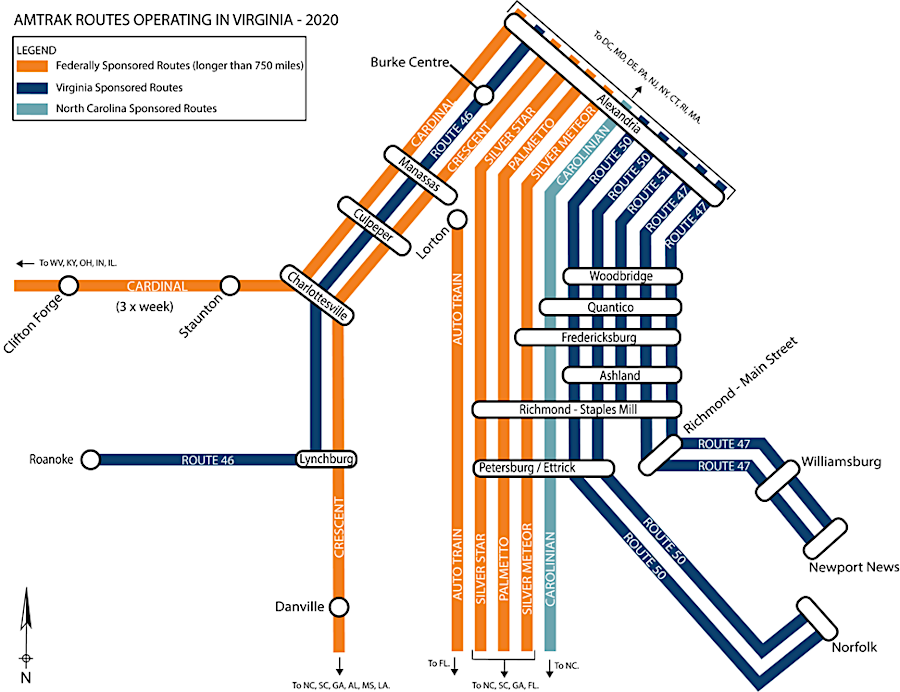
far more Amtrak trains stop in downtown Alexandria compared to downtown Richmond
Source: Virginia Passenger Rail Authority, Board Meeting - December 19, 2020

far more Amtrak trains stop in downtown Alexandria compared to downtown Richmond
Source: Virginia Passenger Rail Authority, Board Meeting - December 19, 2020
Most railroads in Virginia were built to carry freight - not people. Amtrak was created to maintain long-distance passenger rail service rather than freight, and every year Amtrak's operations in Virginia lose money. State and Federal subsidies are required to keep the unprofitable passenger railroad in business.
From the beginning, freight was more important to railroad planners than passengers. The state's first railroad was a freight line built to link the Midlothian coal fields of Chesterfield County with Richmond. The Chesterfield Railroad was designed to haul coal, and the original line was constructed before locomotives were acquired.
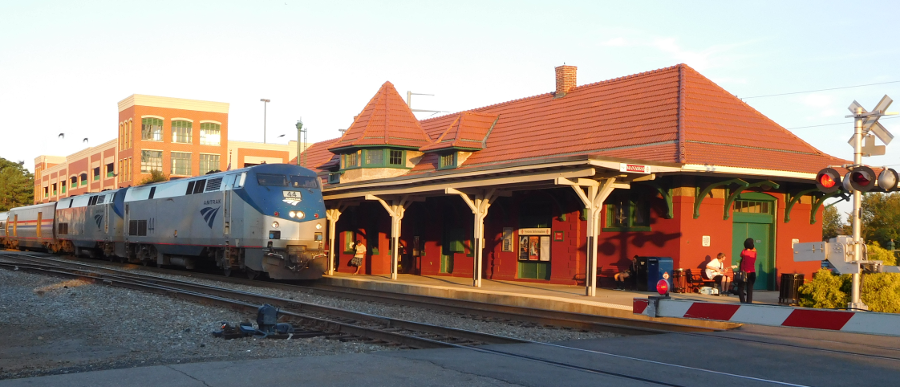
Amtrak runs through Manassas today, over the route initiated by the Orange and Alexandria Railroad before the Civil War
Loaded coal cars were sent downhill by gravity from the mines for 13 miles to wharves on the James River. The "passengers" on Virginia's first railroad were in the last car - mules, who were unloaded at the end of the trip and used to haul the empty cars uphill to be loaded with coal again.1
The only major railroad built primarily for passengers in Virginia was the Richmond, Fredericksburg, and Potomac (RF&P), which is now part of the CSX Railroad. The Virginia and Tennessee Railroad, now part of Norfolk Southern Railroad, also managed to make more revenue from passengers than freight.2
The RF&P was chartered in 1834. It was designed from the beginning to transport passengers between central Virginia and Washington, DC. People traveling between Richmond and Washington would get on an RF&P train in Richmond, ride at 20mph to a Potomac River wharf north of Fredericksburg, then transfer at Aquia Landing to a steamboat to go up the Potomac River to Washington.
Freight traffic was expected to provide only minimal profits. Not until 1900 did revenue from freight exceed RF&P's revenue from passengers.3
Other rail lines expected to make profits from carrying passengers, but more profits from carrying freight. The South Side Railroad, built before the Civil War, twisted through Southside Virginia between Petersburg-Lynchburg to gather tobacco and a variety of freight from small markets in little towns.
The Virginia and Tennessee Railroad extended west from Lynchburg to Bristol. The costs of hauling freight across mountains in wagons pulled by horses or mules were high, and the railroad offered a far more efficient transportation choice for farmers, iron furnaces, salt makers, and lead mines. Passengers also found trains to be faster and more convenient, but the railroads found freight to be more profitable.
After the Civil War, the Shenandoah Valley Rail Road built its line through the Page Valley east of Massanutten Mountain. The route chosen by that railroad illustrates the relative priority of freight vs. passenger traffic.
The Shenandoah Valley Rail Road (soon renamed the Norfolk and Western Railroad) bypassed the Shenandoah Valley towns of Harrisonburg and Staunton west of Massanutten Mountain. Instead, it connected directly with the Big Gem iron furnace east of Massanutten Mountain.
The Valley Rail Road did link all the major towns between Winchester and Staunton, but revenues from the extra passenger traffic was inadequate and the railroad went into bankruptcy. Today, the only rail line still operating through the entire valley uses the route of the old Shenandoah Valley Rail Road east of Massanutten Mountain
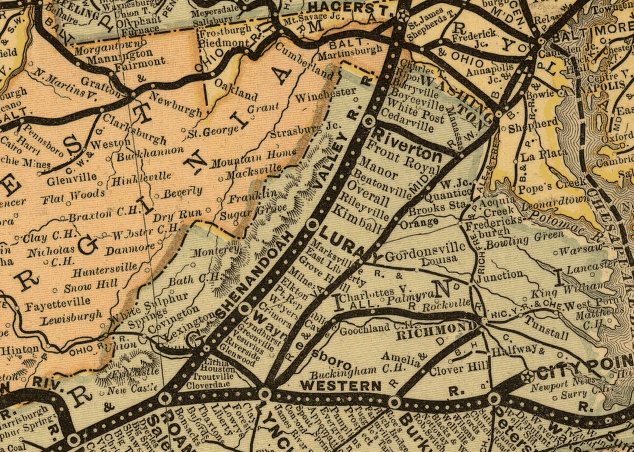
the Shenandoah Valley Rail Road chose to bypass the towns west of Massanutten Mountain in order to access the freight traffic from Big Gem Mine at Milnes (later renamed Shenandoah) east of Massanutten Mountain
Source: Library of Congress, The Virginia, Tennessee, and Georgia Air Line; the Shenandoah Valley R.R.; Norfolk & Western R.R.; East Tennessee, Virginia, & Georgia R.R. (its leased lines,) and their connections (1882)
The last major rail line in Virginia, the Virginian Railway, was constructed in 1909. It bypassed existing towns, letting its competitor (the Norfolk and Western Railroad) have almost all the passenger traffic. Henry Huttleston Rogers, "father" of the Virginian, did not want low-profit passenger trains to complicate the scheduling of the Virginian through-freights to Norfolk that were loaded with high-profit coal.
 The Virginian's more-direct route between Roanoke and Norfolk even bypassed Petersburg. The straighter route enabled the Virginian's passenger trains going between Roanoke-Norfolk to offer a faster, smoother ride, without cars being switched between trains at intermediate stops. One president of the Norfolk and Western sacrificed loyalty to his railroad and chose instead to hook his private car to the Virginian passenger train, when traveling between Roanoke and Norfolk.4
The Virginian's more-direct route between Roanoke and Norfolk even bypassed Petersburg. The straighter route enabled the Virginian's passenger trains going between Roanoke-Norfolk to offer a faster, smoother ride, without cars being switched between trains at intermediate stops. One president of the Norfolk and Western sacrificed loyalty to his railroad and chose instead to hook his private car to the Virginian passenger train, when traveling between Roanoke and Norfolk.4
Before the interstate highways and jets siphoned off the business, passenger traffic could be profitable. At times, Virginia railroads competed for passenger traffic and prestige. The Southern Railway bragged about service on the Crescent, at times operating it as an all-Pullman car train without ordinary passenger coaches, while the C&O advertised its air-conditioned cars were so comfortable that passengers could "sleep like a kitten and arrive fresh as a daisy." The Chessie kitten symbol was used by the Chesapeake and Ohio Railroad and its successor for 50 years, until the CSX logo replaced the kitten in 1986.5
After World War II, railroads began consolidating/abandoning passenger train service, after getting permission from the Interstate Commerce Commission (ICC) to stop unprofitable service. In 1970, the US Congress passed the Rail Passenger Service Act and created the National Railroad Passenger Corporation (Amtrak). The Amtrak Basic System was designed to be supplemented with State Supported trains. By 1972, Massachusetts, Illinois, and Pennsylvania were funding such trains.
In 1971, after the bankruptcy of Conrail made clear that transformation of rail operations was necessary, all but one railroad in Virginia transferred their passenger trains to Amtrak. The Southern Railroad tried to maintain operations, but could not compete with air travel and interstate highways. It turned over its passenger rail operations (including the Crescent crossing Virginia between New York and New Orleans) to Amtrak in 1979.
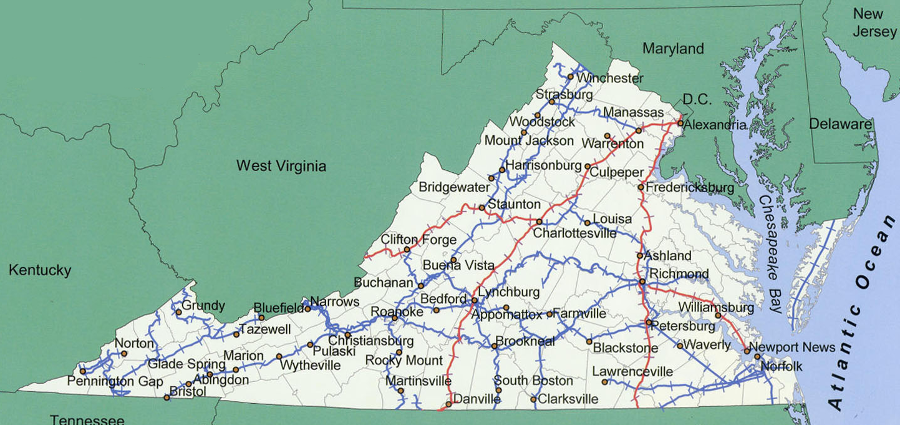
in the year 2000, Amtrak lines (in red) provided passenger rail service to only a small percentage of Virginia's cities compared to freight rail (both red and blue)
Source: Virginia Geographic Alliance, Railroad Transportation, 2000 (derived from Map 39 in "An Atlas of Virginia")
At the start of Amtrak in 1971, long-distance Amtrak passenger trains serviced Charlottesville, Richmond, Newport News, and Norfolk.
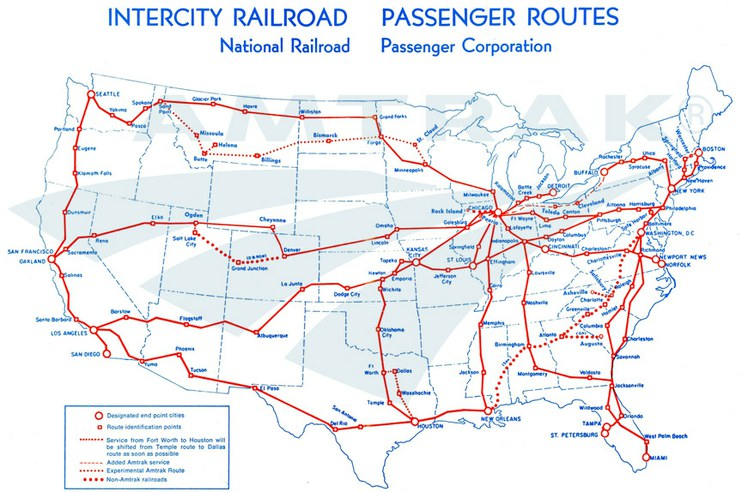
long distance Amtrak service began in 1971
Source: Amtrak, Amtrak System Map, 1971
In 2013, Amtrak operated trains between Petersburg-Richmond-Washington DC (Carolinian Route, Palmetto Route, Silver Star Route, Silver Meteor Route), Norfolk-Petersburg-Washington DC, plus Newport News-Richmond-Washington DC (Northeast Regional Route), Clifton Forge-Charlottesville-Washington DC (Cardinal Route), and Danville-Lynchburg-Washington DC (Crescent Route, Northeast Regional Route). Amtrak also operated the Auto Train between Northern Virginia (Lorton)-Central Florida (Sanford).
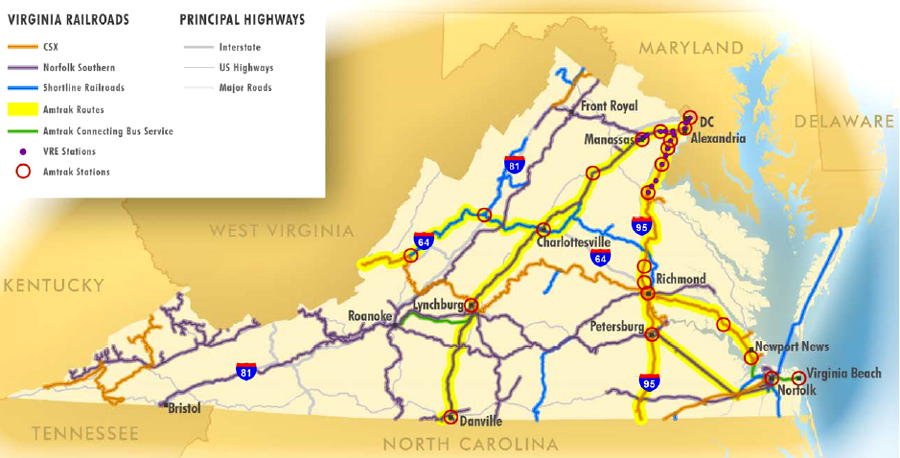
Amtrak routes in Virginia provide no direct passenger connection between Richmond-Charlottesville
Source: Virginia Department of Rail and Public Transportation, DRAFT 2013 Virginia Statewide Rail Plan Overview (p.20)

stations in Virginia where Amtrak's Cardinal passenger trains stop
Source: Amtrak Cardinal Route Guide
The Rail Passenger Service Act that created Amtrak guaranteed it access ("trackage") rights to use railroad lines owned by other railroads, in order to operate intercity passenger trains. Amtrak owns no track in Virginia today; it pays CSX and Norfolk Southern for the use of their private tracks. No Amtrak trains use any track owned by the nine Class 2 "shortline" railroads in Virginia. The shortlines service areas of Virginia with relatively low population density, or in the case or Norfolk offer CSX/Norfolk Southern a neutral third party line for access to port terminals.
Scheduling passenger trains and negotiating costs is a major challenge for Amtrak officials. The private rail companies see passenger rail as a headache that constrains operations of profit-generating freight trains. Passenger trains operate at 79mph, a faster speed than most general merchandise freights, so they use between two-five slots that otherwise would be available for freight trains (according to the freight rail operators).
Amtrak blames its reputation for poor on-time performance (late arrivals/departures) on interference by the rail lines, claiming passenger trains are forced onto sidings or delayed at stations while freight trains receive priority in scheduling.
In 2024, the US Department of Justice filed suit to force Norfolk Southern to comply with the law requiring it to give passenger rail service preference. Only 75% of Amtrak's southbound trains were reaching their destination on time. The lawsuit claimed that freight trains were being given priority consistently. Because the trains were so long, sometimes extending two miles, they exceeded the capacity of sidings that would allow Amtrak trains to pass.
The Chief Executive Officer of Amtrak said:6
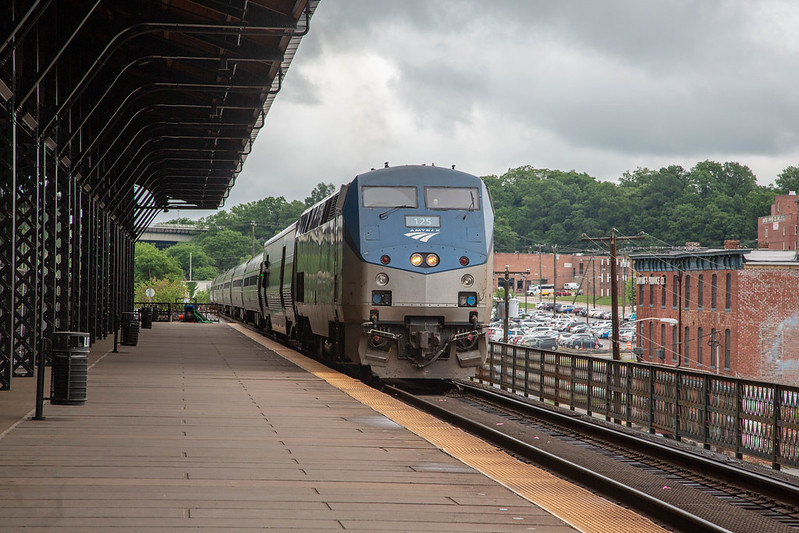
Amtrak at Main Street Station in Richmond, headed to Newport News
Source: Virginia Department of Transportation, Main Street Station
Delays are also caused by speed restrictions imposed by the host railroad. CSX and Norfolk Southern have different criteria for requiring trains to slow down after storms or in hot weather, which can cause steel rails to "kink" and cause a wreck. Each rail line schedules its own maintenance projects, so "slow orders" due to repairs can cause unexpected delays to passenger trains. Capacity utilization is also a factor - even with trackside signals and modern communications to engineers within cabs of locomotives, only a limited number of trains can be dispatched safely through a stretch of track within 24 hours.
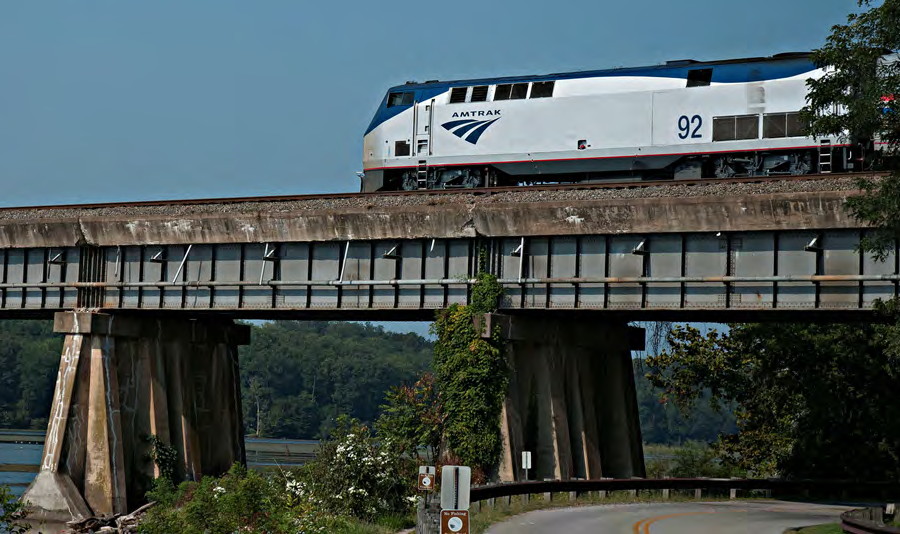
Amtrak uses the CSX rails between the Potomac River and Richmond
Source: SEHSR Tier I EIS Build Alternatives (p.2-11)
In 2005, the General Assembly created the Rail Enhancement Fund and dedicated 3% of the tax on car rentals to finance rail infrastructure and Amtrak operations that expand service within Virginia. Virginia in investing public funds to upgrade the privately-owned rail lines, in part to increase the competitive status of Norfolk vs. other East Coast ports, in part to reduce truck traffic on I-81 and I-64 between Hampton-Richmond, and in part to increase capacity to provide passenger rail service.
Congress decided in the Passenger Rail Investment and Improvement Act of 2008 (PRIIA) to limit Federal support for Amtrak to intercity passenger rail routes of greater than 750 miles between endpoints, plus the Northeast Corridor between DC-Boston. Amtrak was paying the costs to operate the passenger train from Newport News-DC, and the new law required Virginia to absorb the marginal costs for that service or Amtrak would cancel it in October 2013.
Despite the recession then affecting state revenues, and a political deadlock over raising taxes to finance transportation costs, Virginia still committed to expanding rather than contracting passenger rail operations.
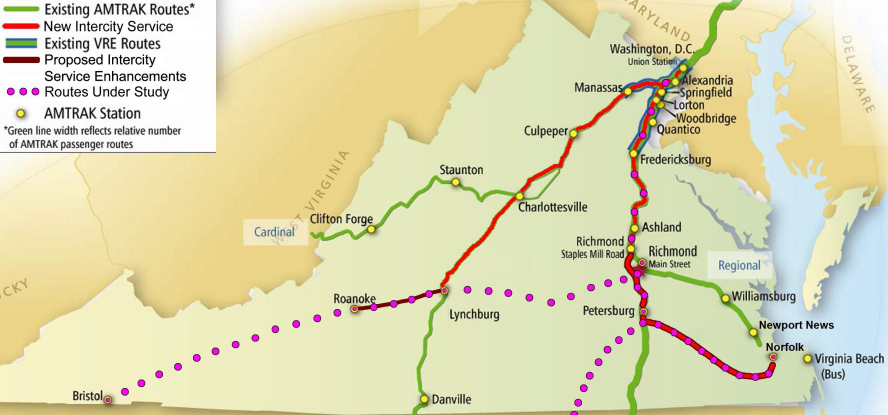
plans for passenger rail service in Virginia include potential expansion to Bristol, plus high-speed rail from the Potomac River to the North Carolina border
Source: Virginia Department of Rail and Public Transportation, Virginia's Approach to Intercity Passenger Rail Development (June 14, 2013)
In 2009, Virginia started to subsidize one train daily between Lynchburg-DC, on a route that had 16 Southern Railway passenger trains daily in the 1950's. The state-supported train was funded after the governor told three Democrats in the General Assembly that they needed to get Republican support for the proposed Amtrak expansion. Three key Republicans partnered with the Democrats within a week, and what was started as a three-year trial project was immediately successful.
In 2010, the state funded an additional train between Richmond-DC. Most Richmond trains leave from the suburban Staples Mill Road north of the city, and with the second state-subsidized train the state capital had 10 trains/day going north to Washington. The renaissance of passenger rail at Richmond (with a 60% increase of passengers between 1997-2012) may have diverted some cars from I-95, but its greatest impact may have been reducing the number of passengers taking the short-distance flights out of the Richmond airport:7
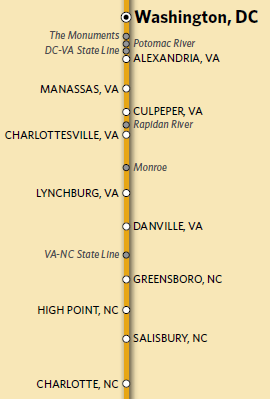
stations in Virginia where the Crescent passenger trains stop
Source: Amtrak Crescent Route Guide
The Lynchburg train has exceeded expectations for customers and revenues. The state projected 51,000 passengers per year, but three years later the "Northeast Regional" from Lynchburg-DC via Charlottesville, Culpeper, and Manassas was carrying 174,000 passengers per year. It collected enough revenue from customer fares to cover costs of operations. However, initial reports that the train "turns a profit" omitted the up-front $43 million in capital costs of adding additional train cars, locomotives, upgrading Norfolk Southern's track/signal systems to handle passenger as well as freight trains, and building the new train station platform at the Kemper Street Station.8
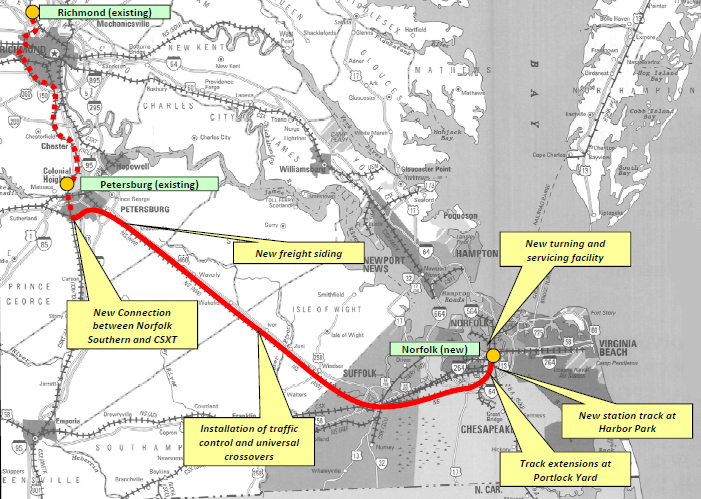
Virginia invested $100 million in state-funded upgrades to CSX and Norfolk Southern rail lines to facilitate Amtrak service to Norfolk
Source: Virginia Department of Rail and Public Transportation, "Amtrak Virginia Extension to Norfolk," Project Map
Amtrak extended service to Norfolk in December, 2012. In preparation, the state spent $100 million from the Rail Enhancement Fund to upgrade the 105-mile Norfolk Southern rail line linking Petersburg-Norfolk, including an unusually long 51-mile stretch of straight track where freight trains reach 60mph. That stretch is part of the Heartland Corridor carrying double-stacked containers of freight between the port and Columbus Ohio. State funding for the Heartland Corridor had subsidized earlier upgrades in Norfolk, as well as west of the Blue Ridge.
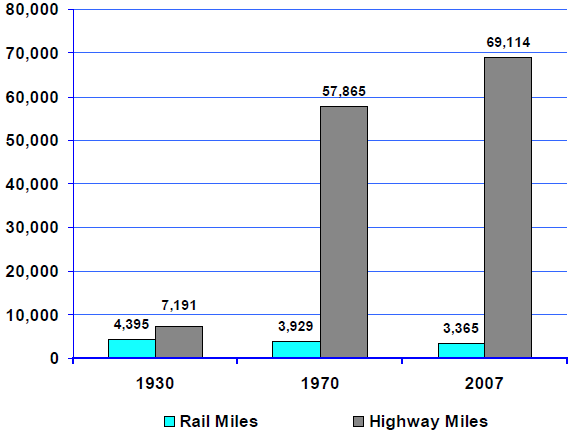
the government-financed highway network in Virginia expanded dramatically in the 20th Century, while the rail network contracted
Source: Virginia Department of Rail and Public Transportation, Virginia's Approach to Intercity Passenger Rail Development (June 14, 2013)
Among other improvements intended to support passenger traffic, a new stretch of track (the "Collier Connection") was built at Petersburg to link the CSX tracks from Richmond with the Norfolk Southern tracks to Norfolk. The upgrade was completed almost a year earlier than planned. In the interim, passengers in Norfolk used a temporary loading platform until completion of the Harbor Park station. That station was built near the site of the old passenger terminal used by the Norfolk and Western and by the Virginian.9
Virginia was the first state to conclude negotiations with Amtrak for subsidizing regional passenger train services, as required by the Passenger Rail Investment and Improvement Act of 2008. Amtrak's Short Term Action Plan for "Advancing Passenger Rail in the State of Virginia" planned to expand service across the state.
Amtrak continued to pay for the long-distance trains (going more than 750 miles) that cross Virginia. The state committed to pay $10.5 million annually for six years for Amtrak to continue regional passenger train service from Lynchburg, Norfolk, Newport News, and Richmond. The 2013 General Assembly passed a new set of taxes to fund transportation, and that bill dedicated sales tax revenue to the Intercity Passenger Rail Operating and Capital Fund (IPROC).10
The new Norfolk station was more convenient for customers living in Norfolk/Virginia Beach than the Newport News station, which was located on the northern side of the James River. Amtrak used the CSX line to get from Richmond to Newport News. Passenger trains going from Richmond to Norfolk, south of the James River, used CSX lines down to Petersburg but then went east on Norfolk Southern's track to Norfolk.
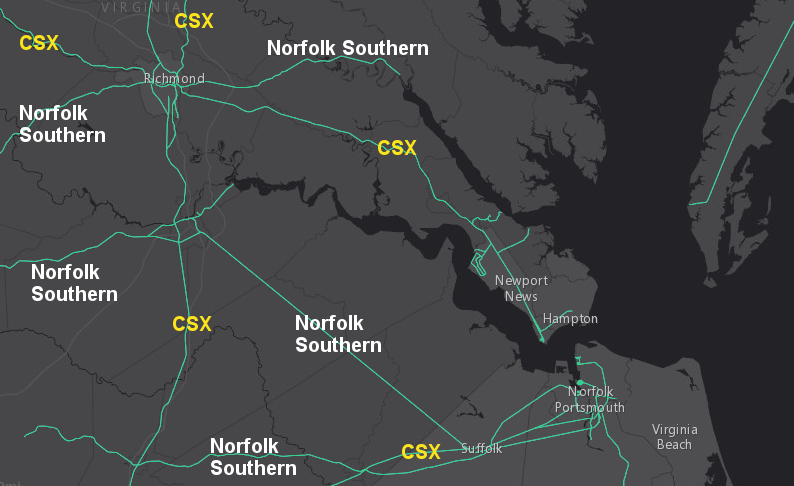
Amtrak uses CSX tracks to reach Newport News, and Norfolk Southern tracks to get from Petersburg to Norfolk
Source: ESRI, ArcGIS Online
Ridership at the Newport News station dropped 37 percent in the summer of 2014, but the state committed enough new funding in 2014 to match Federal grants for a $38 million multi-modal transportation center to upgrade the railroad tracks and station on the Peninsula. Newport News remained the "end of the line" for passenger rail, and the track upgrade was designed for Amtrak to reverse its trains in ten minutes vs. one hour.11
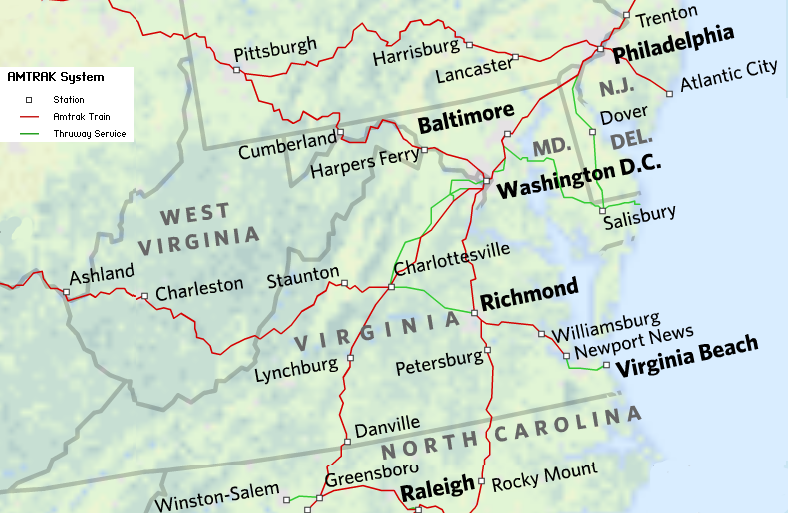
Amtrak routes in Virginia, as of July 2013 (six months after Amtrak's passenger rail service started to Norfolk, the route map still omitted it...)
Source: Amtrak Route Atlas
Just 55 miles west of Lynchburg is Roanoke, which was the next target for passenger rail expansion in Virginia. In 2013, after the General Assembly approved new taxes and fees to fund transportation, the governor announced plans to provide passenger rail service to Roanoke by 2017.
The Commonwealth Transportation Board (CTB) committed the first round of funding of the $100 million expected to be needed to upgrade the Norfolk Southern track and build platforms at rail stations. At the official announcement, attended by the Chief Executive Officers of Amtrak and Norfolk Southern as well as the governor, the mayor of Roanoke said:12
In a more jovial reference, the governor of Virginia acknowledged the political assistance from Onzlee Ware, delegate for Roanoke in the General Assembly. Ware supported significant tax increases in the governor's 2013 transportation initiative, recognizing that the initiative created the mechanism to fund extension of Amtrak service to Roanoke. In his 2014 (and last) State of the Commonwealth Address, Governor McDonnell joked how Ware had retired shortly after being re-elected in November, saying:13
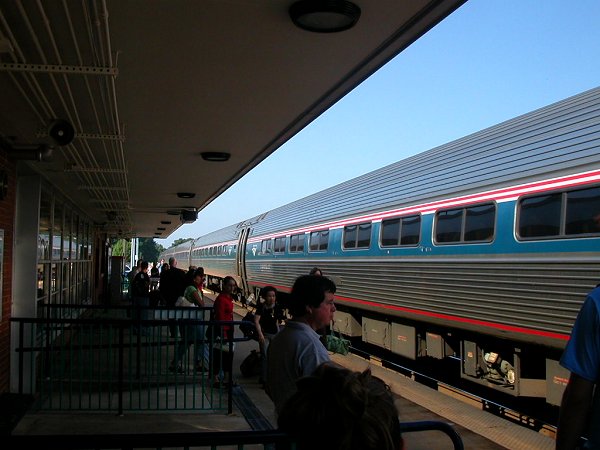
Amtrak at Quantico station
Once Amtrak reached Lynchburg, a bus funneled Roanoke customers to the train station there. The demand for passenger rail from Roanoke may have contributed to the higher-than-expected ridership on the Lynchburg line. A bus link to connect Roanoke with the Amtrak Cardinal in Clifton Forge, 50 miles to the north, was not implemented.
In Roanoke, a new platform was completed near the bus station, offering the potential to create a multi-modal transportation hub. The historic Norfolk & Western train station (now a museum dedicated to O. Winston Link's extraordinary photographs of steam trains) was no longer suitable, because Amtrak passenger trains at that location would block freight traffic.14
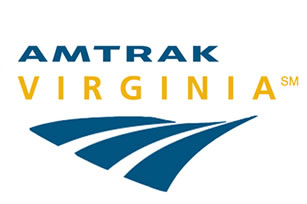
Amtrak and the Commonwealth of Virginia partner to offer train service on routes less than 750 miles
Source: Amtrak Amtrak Virginia
The 2008 Virginia State Rail Plan indicated a passenger rail stop would be located at Bedford. The town (Bedford gave up its status as a "city" in 2013) had lost its passenger train service in 1971 and the old station was converted into a restaurant.
However, after the state committed to extending Amtrak service to Roanoke, it declined to include a stop at Bedford. Bedford is halfway between Roanoke and Lynchburg, and residents used the Smart Way Connector (the bus service from Roanoke to Lynchburg) to catch passenger trains in Lynchburg.
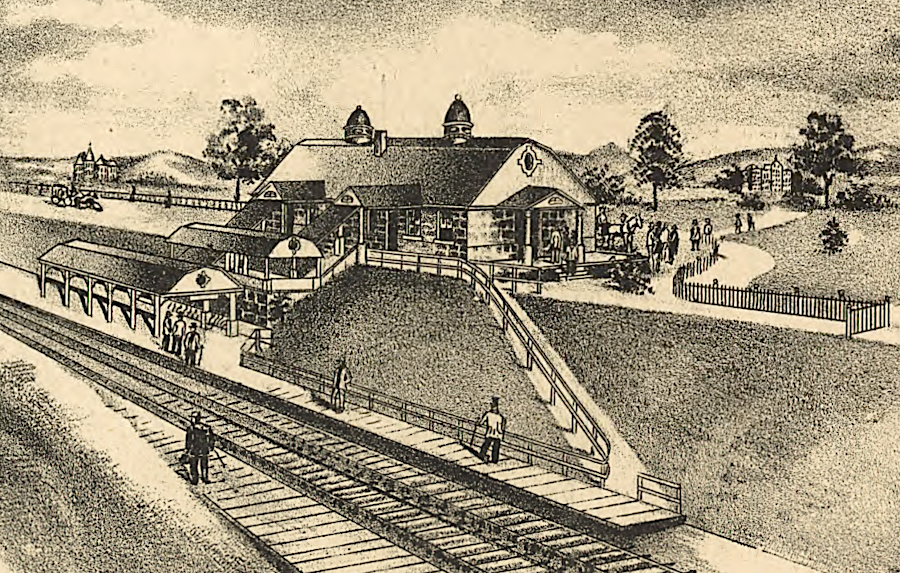
Bedford rail station in 1891
Source: Library of Congress, Perspective map of Bedford City, Va., county seat of Bedford Co. (1891)
The high costs for replacing the rail station, and the small number of new passengers it would attract, were primary factors in blocking Bedford's initial request. In 2014 the Virginia Secretary of Transportation rejected the request to have Amtrak stop in Bedford when Amtrak service is extended 53 miles to Roanoke. He declared that the town was in the "travel shed" of Lynchburg, and:15
In that rejection notice, the Virginia Secretary of Transportation noted that every station stop delayed service to distant locations. The population and number of businesses in Bedford did not justify the additional delay.
| 2010 Census Data | Roanoke | Lynchburg | Bedford |
|---|---|---|---|
| Population | 96,922 | 75,568 | 6,222 |
| Persons per square mile | 2,280 | 1,538 | 905 |
| Total number of firms | 7,102 | 4,795 | 591 |
| Source: Virginia Secretary of Transportation letter, February 10, 2014 | |||
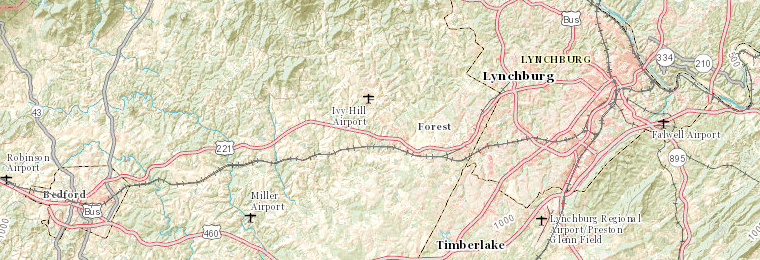
the old Virginia and Tennessee Railroad line, going southwest from Lynchburg to Bristol, will be used for extending Amtrak service through Bedford to Roanoke
Source: US Geological Service (USGS), The National Map
In response, local officials organized a Bedford-Franklin Regional Rail Initiative in 2014 to build support and justifications for changing the state decision. The town completed a "Town of Bedford Passenger Rail Station Feasibility Study and Conceptual Plan" and got the Virginia Department of Rail and Public Transportation to complete an "Intercity Passenger Rail Service Study" in 2016.
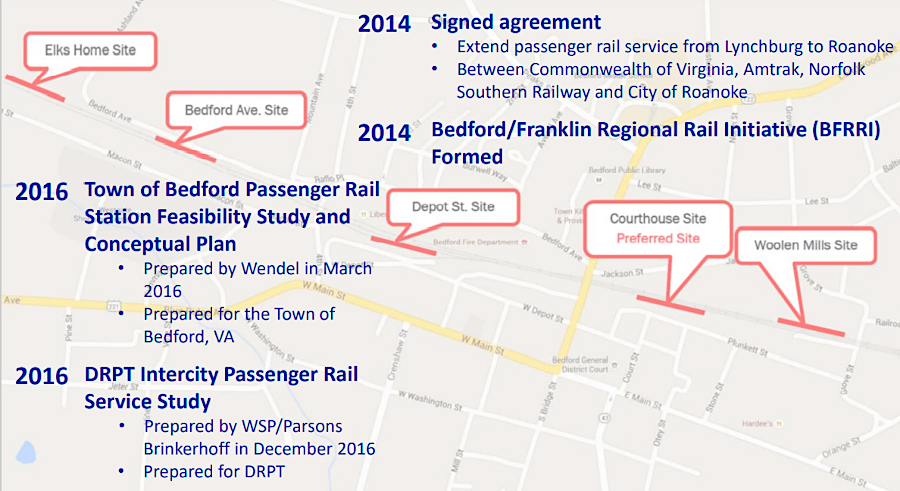
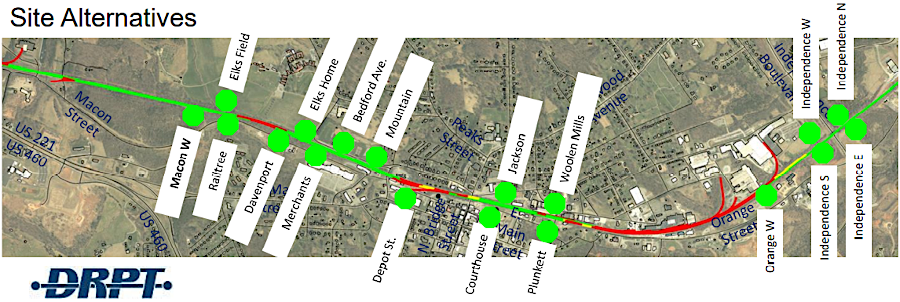
getting Amtrak to stop in Bedford required multiple studies and evaluation of new sites for a depot
Source: Virginia Department of Rail and Public Transportation (DRPT), Bedford/Franklin County Regional Passenger Rail Stop Study (October 25, 2021)
In 2019 the Virginia Department of Rail and Public Transportation funded a study to examine the potential of re-establishing a rail station. It concluded that adding a stop in Bedford would add another 10,000 passengers (20,000+ on-off boardings) annually to Amtrak travel. Statewide, adding Bedford would result in a 6% increase in total rail passengers.
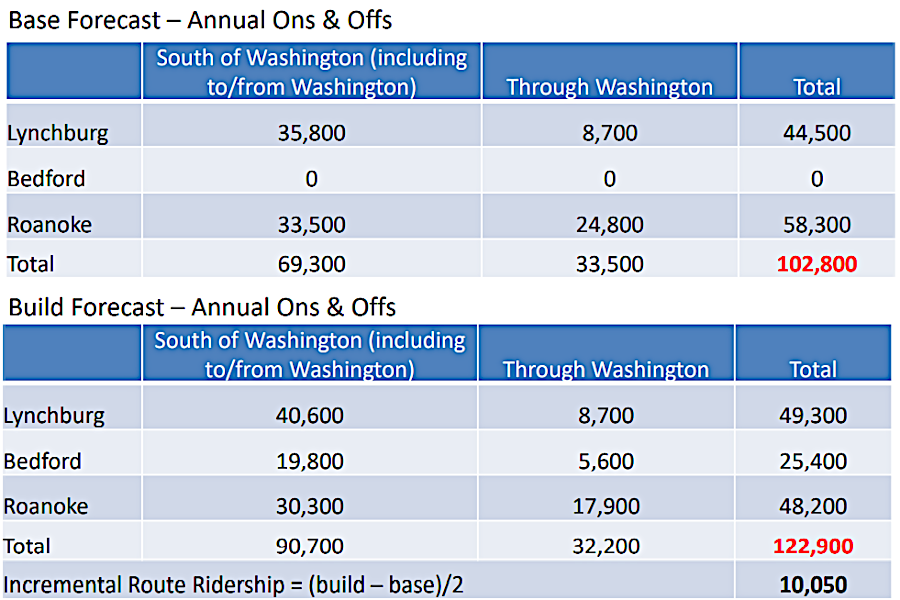
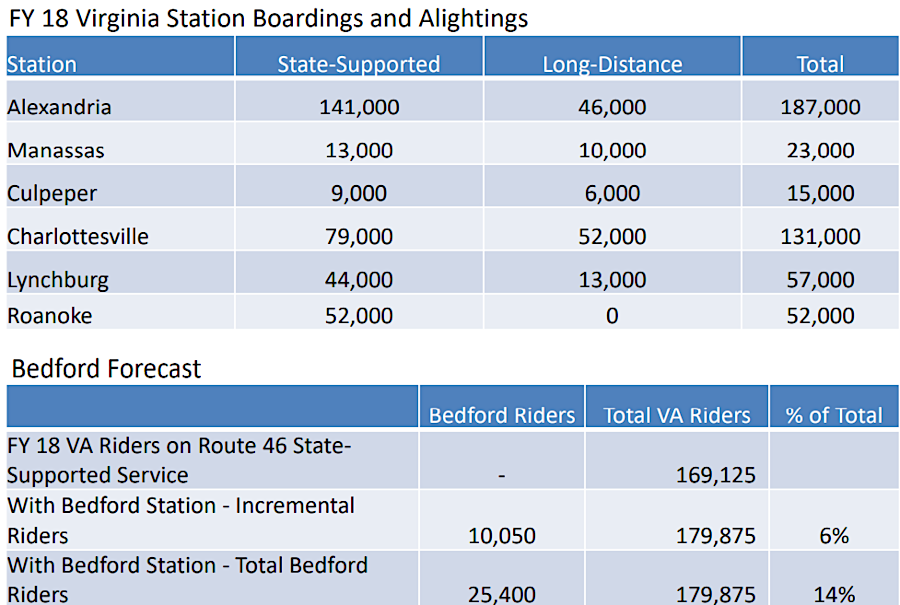
in 2021, the state concluded that adding a stop in Bedford would increase overall Amtrak passenger use
Source: Virginia Department of Rail and Public Transportation (DRPT), Bedford/Franklin County Regional Passenger Rail Stop Study (October 25, 2021)
Town officials wanted to place the new depot near the courthouse in the central business district, but that created interference with Norfolk Southern freight rail operations and increased safety concerns. Railroad officials did not support adding a stop where track was curved. In addition, the existing Grove Street crossing of the tracks would have to be closed.
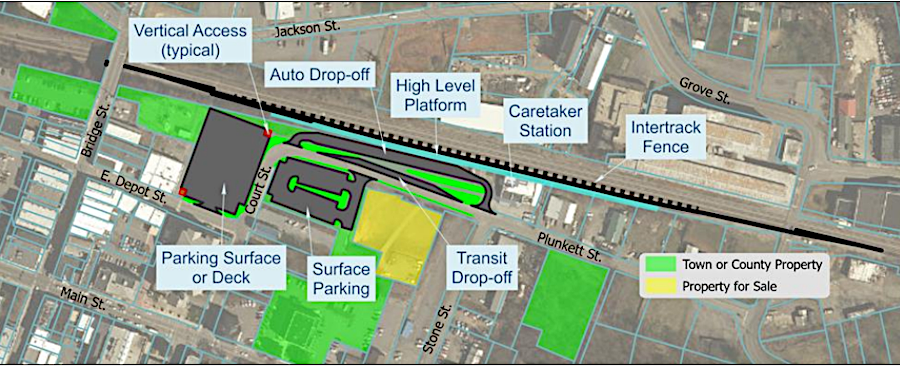
Bedford officials preferred the option of placing a new Amtrak station next to the courthouse
Source: Virginia Department of Rail and Public Transportation (DRPT), Bedford/Franklin County Regional Passenger Rail Stop Study (October 25, 2021)
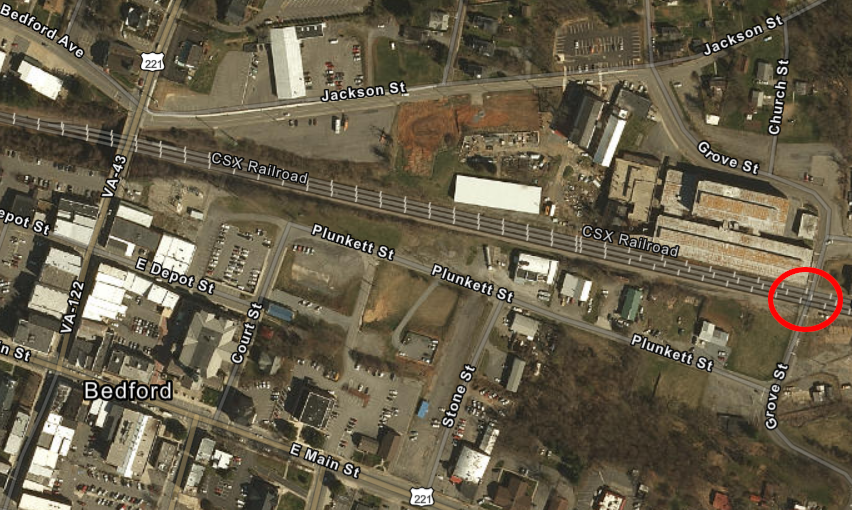
using the Courthouse site along Plunkett Street for a Bedford Amtrak depot would have required closing the Grove Street at-grade crossing
Source: ESRI, ArcGIS Online
The Macon Street East (Merchants) site one mile away was chosen, where low-speed track siding could be added along a section of straight track. A new station at the selected site would projected to cost $11 million.
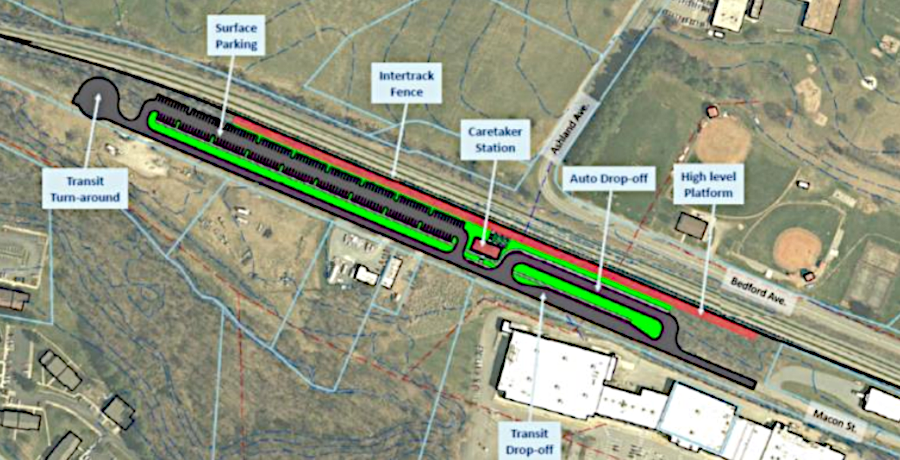
the Macon Street East (Merchants) site was chosen in part because there was a stretch of straight track there
Source: Virginia Department of Rail and Public Transportation (DRPT), Bedford/Franklin County Regional Passenger Rail Stop Study (October 25, 2021)
Since 2017, Amtrak has passed through Bedford without stopping while on the way to and from Roanoke. The town received a $1.5 million grant to prepare for a rail stop in 2024 from the US Department of Transportation's Consolidated Rail Infrastructure and Safety Improvements (CRISI) Program, but that was a small percentage of overall required funding. An updated 2023 cost estimate to build a train station at the Macon Street East (Merchants) site calculated the price as $23 million. The 20% local funding match would require Bedford to pay over $4 million:16
The Town of Bedford got a $1.5 million Federal Rail Administration grant in 2024 to fund dvelopment of the Amtrak stop proposal to the 30% design phase. The Town Manager said it was funding the local 20% match for the grant, but sought regional/state support for future development phases:17
Various studies by the Virginia Department of Rail and Public Transportation document a vision of expanding passenger service beyond Roanoke to Bristol on the Virginia/Tennessee border. The proposed TransDominion Express, which was once proposed to be completely independent of Amtrak, would connect Bristol with both Richmond and Washington. Even if operating at 79mph between stops, a rail trip from Bristol to Roanoke would take 1-2 hours longer than driving by car.18
To enable passenger train travel from Bristol, one-time funding would be required to upgrade the Norfolk Southern line to minimize interference with freight rail operations. Additional public funding would be required to purchase trainsets (locomotives and passenger cars). Ridership projections in 1998-2002 assumed an annual subsidy would be required, beyond the start-up and replacement capital costs, to support annual operations.
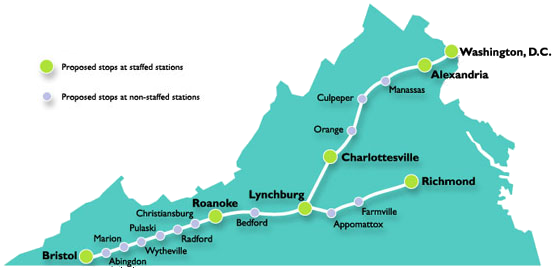
the TransDominion Express proposal proposed extending passenger rail to Bristol
Source: TransDominion Express, Route Map
Until the General Assembly approved new taxes/fees to fund rail operations in 2013, budget constraints blocked all efforts to convert the TransDominion Express concept into an actual program. Once the transportation funding deadlock was broken in 2013, Bristol's opportunity to get Amtrak service increased significantly.
Wytheville started making plans for a new railroad depot, while Bristol's leaders sought support from Tennessee to extend service even further south and create a through-train rather than leave Bristol at the end of the line. Building support for the necessary investment was recognized as a long-term effort:19
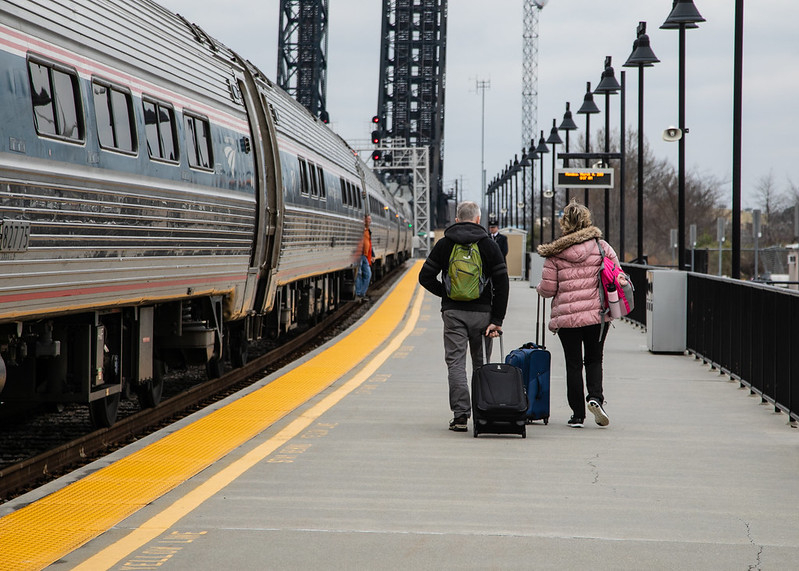
passengers at Norfolk station, next to Harbor Park
Source: Virginia Department of Transportation, Main Street Station
The extension of passenger rail to Roanoke has guided the further expansion of passenger trains in southwestern Virginia. Direct passenger rail service from Roanoke did not cannibalize the existing traffic boarding at Lynchburg, so the state was not forced to subsidize annual operations from Roanoke/Lynchburg.
Ridership expanded as service expanded to Roanoke and fares by customers covered the additional operating costs, so extending Amtrak to Bristol became financially feasible.
Extending Amtrak south to Bristol was delayed in 2018. Norfolk Southern dropped out of a Virginia Department of Rail and Public Transportation study examining the potential to bring passenger rail service to the New River Valley and Bristol. On the other end of the line, state officials decided that Long Bridge widening was needed before the rail passenger network could be expanded within Virginia.
A ridership and revenue projection study completed in 2018 concluded that $30 million in track improvements would be required. An investment of that amount to bring Amtrak to Bristol would create a net increase in passengers:20
As a result of expansion to Roanoke, in 2018:21
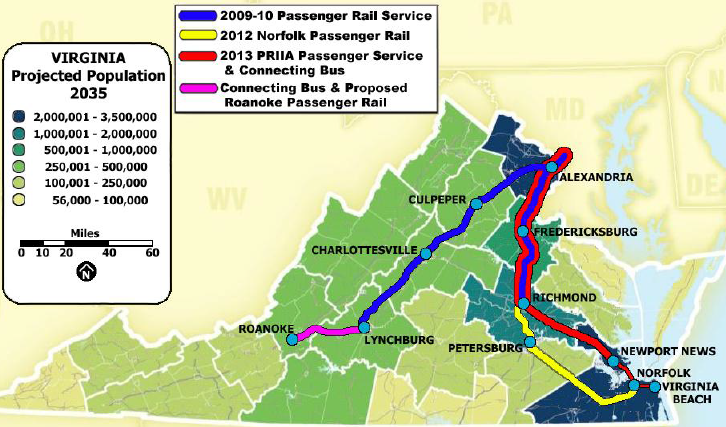
initially, state-subsidized Amtrak routes in Virginia were located in areas of greatest population density
Source: Virginia Department of Rail and Public Transportation, DRAFT 2013 Virginia Statewide Rail Plan Overview (p.21)
Despite the potential, service to Bristol was not included in 2019 when Gov. Northam announced plans to expand passenger rail service. The number of Amtrak trains in Virginia would double over the next 10 years, but the number of stations where trains would pick up passengers would not increase. Without cooperation of Norfolk Southern, the state chose to focus on expanding Amtrak service where CSX controlled the tracks. However, Governor Northam identified where expansion could occur next. Eliminating the Long Bridge bottleneck over the Potomac River:22
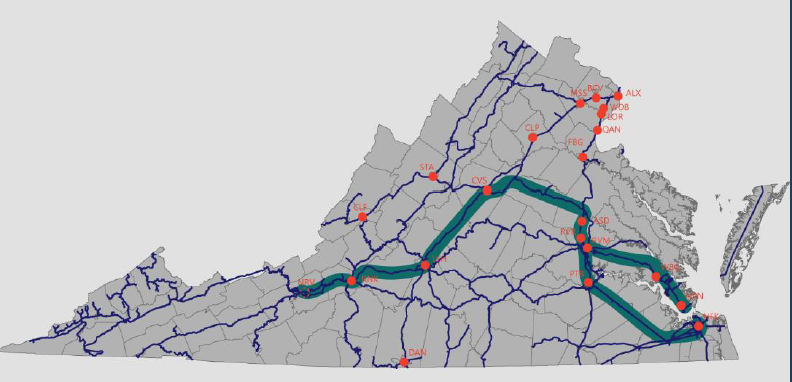
Amtrak stations in 2020, before expansion to Christiansburg
Source: Virginia Passenger Rail Authority, Board Meeting Packet (April 26, 2021)
The Virginia Department of Rail and Public Transportation did not start a study, authorized by the General Assembly in 2017, to expand passenger rail line service to the New River Valley. Instead, Governor Northam skipped the step of doing a study first. He proposed a 2021 budget amendment to commit $50 million to acquire right-of-way and negotiate a deal with Norfolk Southern to facilitate extension of passenger rail from Roanoke to Christiansburg. The existing track was still an active freight line, though the closure of coal-fired power plants in Virginia and reduced worldwide demand in response to climate change concerns had reduced the number of "coal drags" going from West Virginia to Norfolk.
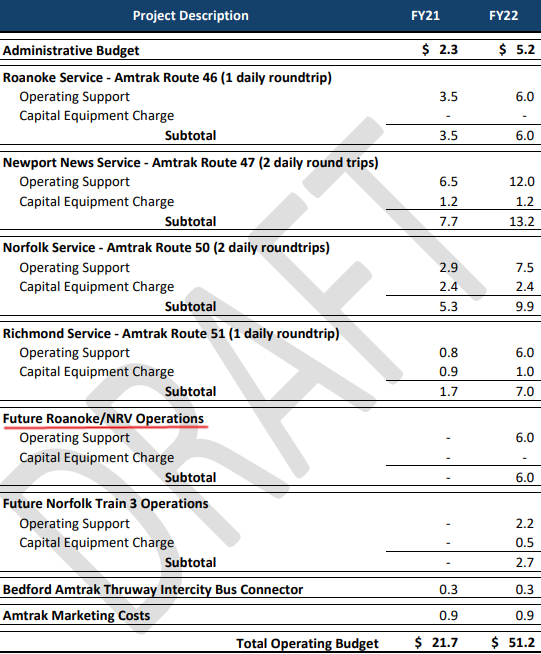
the first budget for the Virginia Passenger Rail Authority, established in 2020, included funding for expansion to New River Valley
Source: Virginia Passenger Rail Authority, Virginia Passenger Rail Authority Operating Budget (2020 Powerpoint)
The obvious demand for transportation alternatives to driving cars on overcrowded I-81 was one reason for the state planning to spend $50 million without another study. The Virginia Breeze bus service between Blacksburg and Washington, DC had been predicted to carry 7,000 riders annually, but there were 29,000 riders in 2019. The Roanoke Times reported in 2020:23
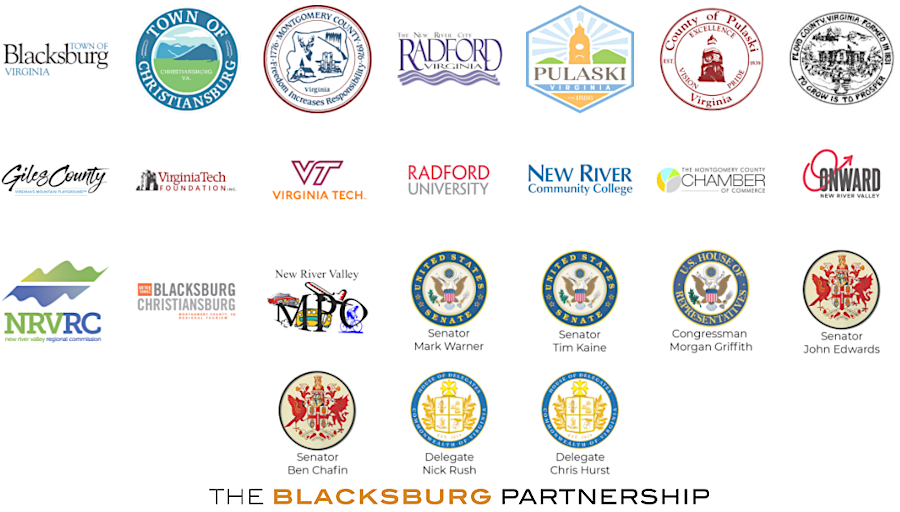
a wide range of government and non-government organizations partnered to bring passenger rail to the New River Valley
Source: New River Valley Passenger Rail, Who We Are
The New River Valley Regional Commission completed a study in 2016 that identified multiple sites in Christiansburg and Radford for a new a train station. Christiansburg acquired eight acres of land for a train station, even as the former train station site at Radford remained a logical alternative. An official with the New River Valley Passenger Rail group listed "Next Stop: Christiansburg" on its website, and noted regarding Radford:24

multiple locations for a train station in the New River Valley were identified in a 2016 study
Source: New River Valley Regional Commission, New River Valley Passenger Rail Study (p.5)
The City of Radford, Montgomery and Pulaski counties, and the towns of Blacksburg, Christiansburg, and Pulaski joined the New River Valley Passenger Rail Station Authority. In the end, the Blacksburg/Christiansburg area rather than Radford was chosen as the destination for expanding passenger rail south of Norfolk. In 2021, Governor Northam announced a deal to add a second train to the DC-Roanoke route, with service to be extended to Christiansburg in 2025 after track was upgraded and a new station was completed. 0
By the end of 2021, the New River Valley Passenger Rail Station Feasibility Study had identified four possible locations for a new train station on the old route of the Virginian Railway. A fifth option, North Franklin East, was eliminated because it was located on the old Norfolk and Western Railway route still getting heavy use by the Norfolk Southern for its freight trains.
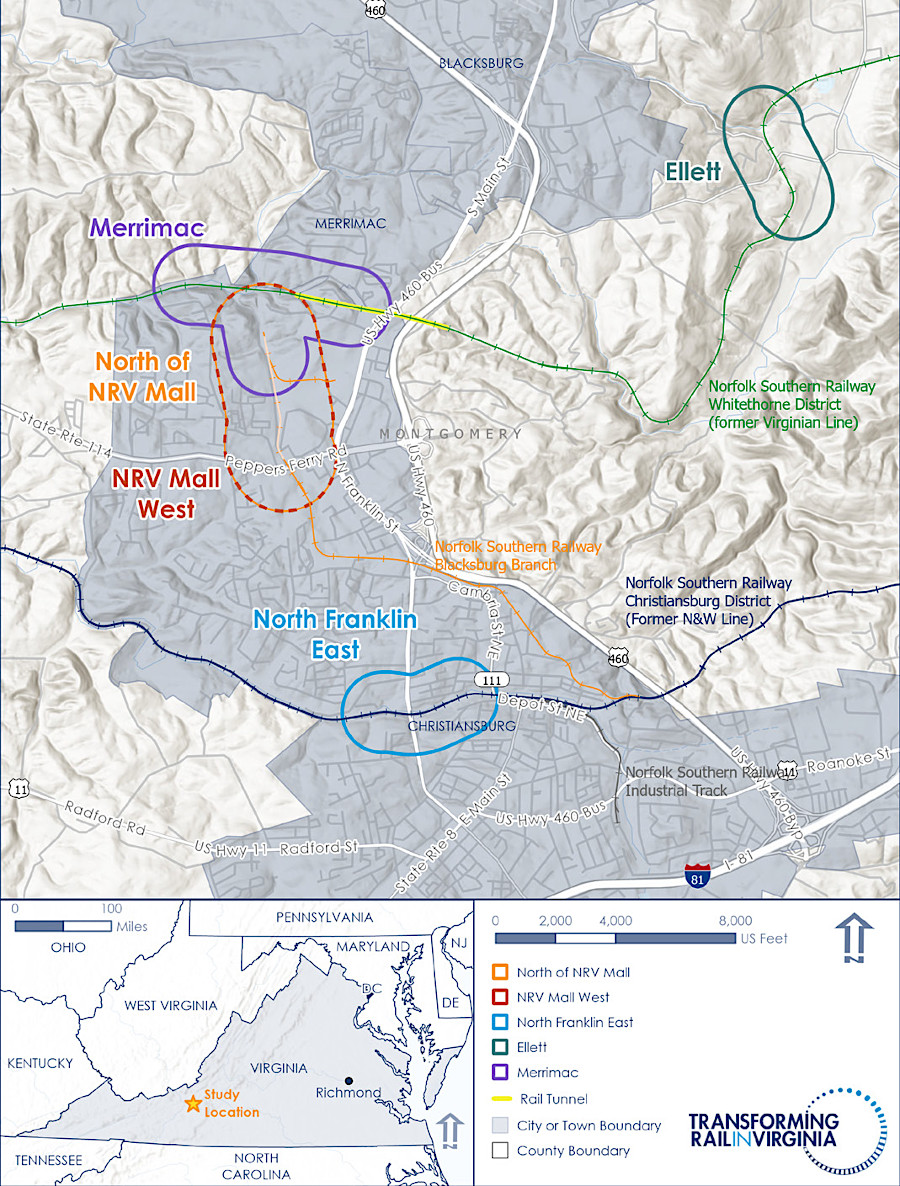
in 2021, the New River Valley Passenger Rail Station Feasibility Study identified four locations for studying construction of a new train station while eliminating the North Franklin East option
Source: Virginia Passenger Rail Authority, New River Valley Passenger Rail Station Fact Sheet (February 2022)
The option of a station in Christiansburg was dropped after the state agreed to purchase over 28 miles of track and right-of-way from Norfolk Southern between Roanoke and Christiansburg. The Virginia Passenger Rail Authority acquired a stretch of the old Virginian Railroad line. That stretch, between Salem Crossovers-Merrimac, was north of Christiansburg.
Several sites were feasible for a station on that route, Most locations where track design would accommodate a station were distant from where a station would facilitate transit-oriented development. Building a station at the Uptown Christiansburg mall was a distinct possibility, but would require a spur track for a connection.
The Town of Christiansburg had purchased land for a potential station on the old Norfolk and Western Railway track. The Virginia Passenger Rail Authority purchase meant that location would be unsuitable, because it was on the primary track for Norfolk Southern to continue to haul coal and other freight. The town's investment was not wasted; there was always a fallback plan to use the property to expand parking at the adjacent Christiansburg Aquatic Center on North Franklin Street.
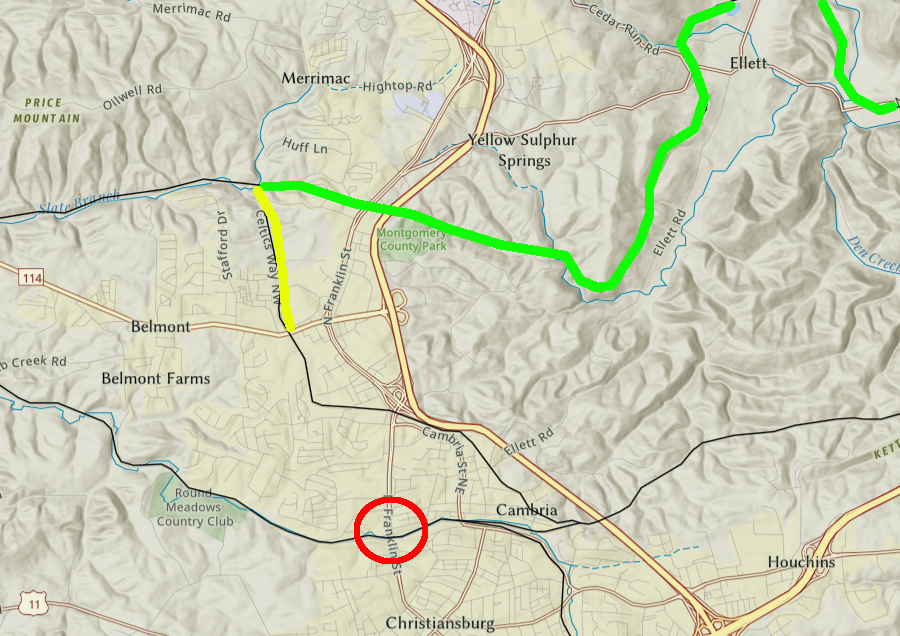
the original Christiansburg location (red circle) was dropped when the state purchased the old Virginian Railway track (green), but a connection (yellow) to the Uptown Christiansburg mall was possible
Source: ESRI, ArcGIS Online
The purchase was part of the $257 million Western Rail Initiative, which was part of the statewide $3.7 billion Transforming Rail in Virginia initiative. The Western Rail Initiative also included improvements far to the north. Adding a seven mile siding from Nokesville to Calverton was needed to create a continuous two-track corridor between Manassas and Remington, speeding the movement of trains between Christiansburg-Washington.
Governor Northam noted:25
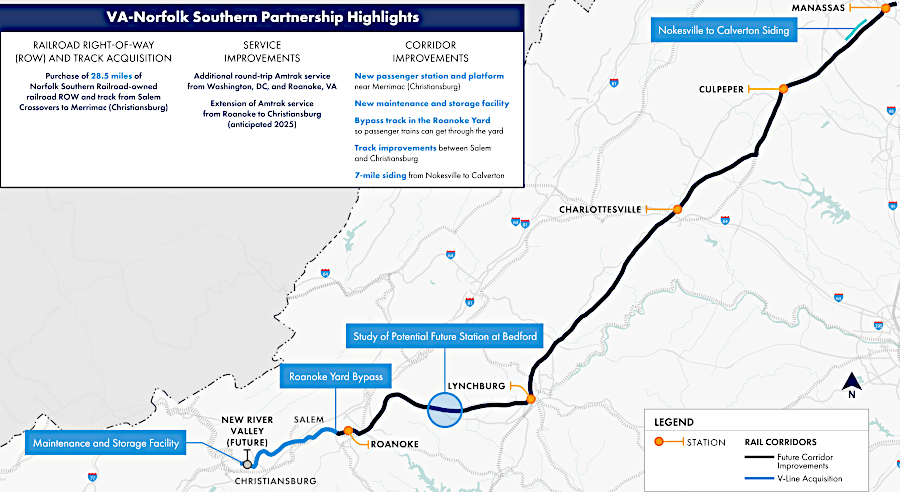
extending Amtrak service to Christiansburg included upgrades to the track as far north as Manassas
Source: Virginia Department of Rail and Public Transportation, Transforming Rail in Virginia
Far more visionary than the TransDominion Express was a 2007 proposal to connect Dulles International Airport to Richmond by passenger rail. Consultant Jim Crupi, perhaps seeking to stimulate some out-of-the-box creativity for regional planning, advised Richmond-area leaders to build:26
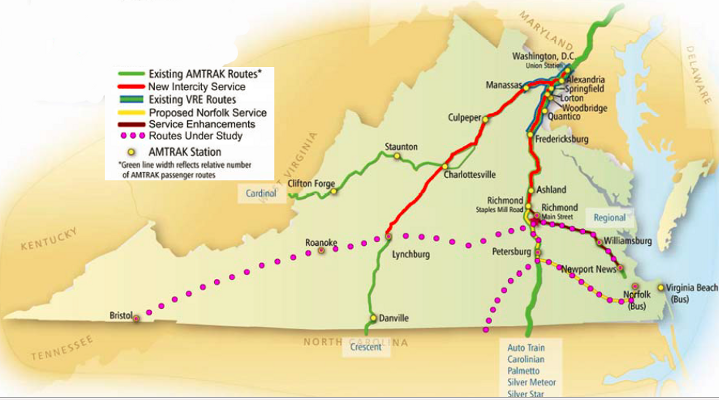
Passenger rail routes in Virginia, operational and planned as of 2010, showing expansion to Norfolk that was implemented in 2012
(other purple dots show proposed extension of Amtrak to Roanoke, Bristol-Richmond connection, and high-speed rail south to Raleigh)
Source: Virginia Department of Rail and Public Transportation, Funding Strategies for State Sponsored Intercity and High Speed Passenger Rail (November 2010)
The Silver Line of the Washington Metro offers passengers the option of taking a train east to Tysons and the District of Columbia, but there has been no railroad connection to Dulles since the airport was constructed. The last substantial traffic on the Washington and Old Dominion (W&OD) railroad was carrying construction supplies to build the airport; afterwards, the line was abandoned and converted into a biking/hiking trail.
The lack of freight rail access to Dulles was noted during the 2013 debate over the Bi-County Parkway, a road proposed between I-66 and Route 7 cutting through areas in Loudoun/Prince William county that were zoned for low-density development. One justification used by the Virginia Department of Transportation (VDOT) was that the proposed road would trigger economic development, by making Dulles into a hub for freight traffic in addition to passengers.
Opponents challenged VDOT's claims that a new road was required to increase the ability of trucks to access Dulles from the south and west, since air freight typically consists of high-value, light-weight, low-volume products such as flowers, computer chips, and sea food. Bi-County Parkway opponents argued the road was designed to spur residential growth rather than air freight; increasing cargo at Dulles did not require a new "truckway" for 18-wheel trucks any more than it required a freight rail connnection.27
The Metropolitan Washington Airports Authority had ambitious plans for converting Dulles into the cargo aviation equivalent of the ports at Hampton Roads. As outlined in the airport's 2009 "missing links" report:28
If you use the old adage to "follow the money," the Metropolitan Washington Airports Authority was far more interested in Metrorail extension to the airport than in the hypothetical benefits of other rail connections. Substantial amounts of political capital were spent to obtain over $5 billion to build the Silver Line to the passenger terminal at Dulles. Proposals for a passenger/freight rail connection to the Norfolk Southern line at Manassas were floated but then ignored; lobbying efforts focused exclusively on building new roads.
"Multi-modal transportation hubs" involving passenger rail in Virginia do not include direct access to airports. Passenger train stations are located in downtowns, or along corridors of development over 150 years old. Virginia's airports were built on the periphery of urban areas, before development pressures increased the cost of land.
As a result, today's Amtrak customers must unload their luggage at the passenger train station, then catch a taxi to get to an airport. Northern Virginia offers a rail connection to its two commercial passenger airports, but their is no Amtrak station to either one. Passenger train passengers have the option at Alexandria to access Reagan or Dulles airports by a "mode shift" to Metrorail. Norfolk could mimic that in the future, if the Tide light rail system is expanded to Norfolk International Airport.
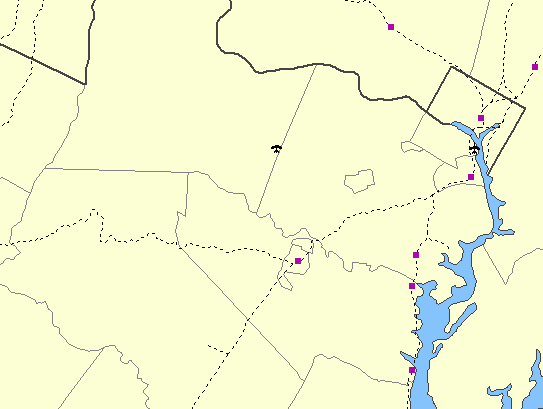
most airports were constructed where land costs were low, far from urban corridors and downtowns - and far from today's Amtrak stations (purple squares)
Source: US Geological Survey, National Atlas
In 2019, Governor Northam announced a $3.7 billion Transform Rail in Virginia plan for a major expansion of passenger rail capacity. CSX agreed to sell, for $525 million, the right-of-way required to build two passenger tracks (next to the existing two tracks) extending from L'Enfant Plaza in the District of Columbia to downtown Richmond, though a third track was not planned through Ashland. The private railroad also sold permanent passenger train rights to the Commonwealth of Virginia for operating from Richmond south to Petersburg, plus 75 miles of abandoned railroad right-of-way between Petersburg and Ridgeway, North Carolina.
What is now the abandoned railroad right-of-way south of Petersburg had been started initially by the Richmond, Petersburg & Carolina Railroad. That track was completed after the railroad was incorporated into the Seaboard Air Line in 1900. After the Seaboard Air Line merged with the Atlantic Coast Line in 1967, what was known as the S-Line to Norlina was formally abandoned in 1986. Though track was removed a year later, building new track on the right-of-way has been proposed as part of a high-speed rail extension to Raleigh, North Carolina.
In addition, the state acquired all of the CSX-owned track and right-of-way between Doswell and Clifton Forge, a total of 186 miles. That operational line was being used by the Buckingham Branch Railroad to transport freight, especially empty coal cars returning from Newport News to the West Virginia coal fields. State ownership would facilitate future development of east-west passenger rail, linking Richmond to Charlottesville and Staunton.
The goal was to double Amtrak state-supported and Virginia Railway Express (VRE) Fredericksburg Line service, and to add VRE weekend service. It met Amtrak's vision to compete with airlines by increasing traffic in the 300-mile short-haul market with connections to major urban centers. Amtrak agreed to invest $944 million to upgrade and increase service.
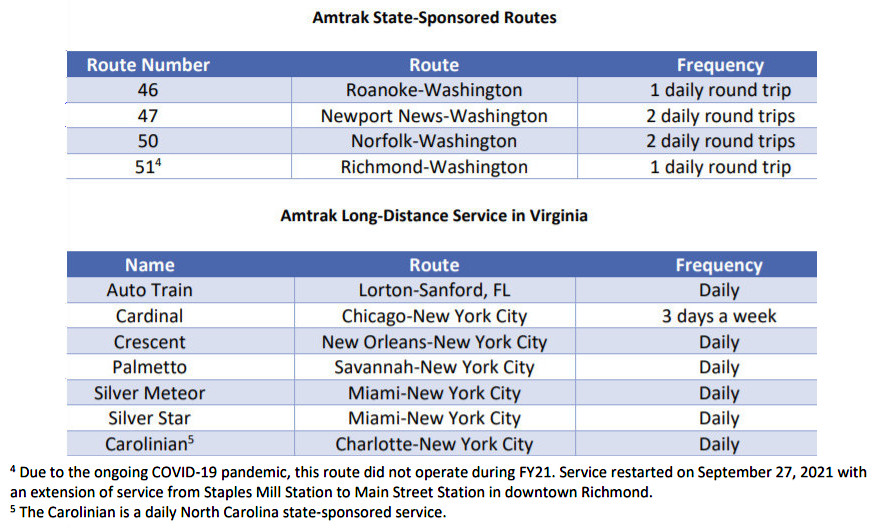
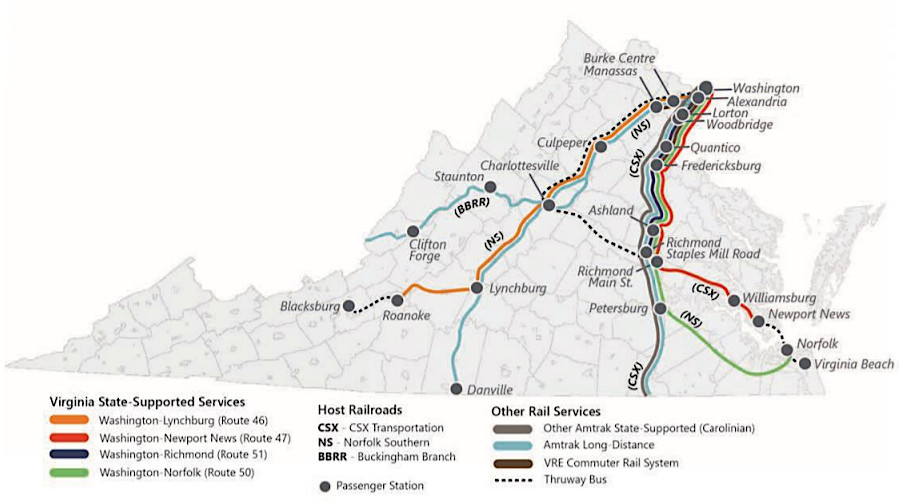
Amtrak trains in Virginia, operating in 2021
Source: Virginia Department of Rail and Public Transportation, Fiscal Year 2021 Report (p.4, p.26)
The initial expansion was expected to include one new roundtrip between Washington, DC and Norfolk, VA and one new roundtrip on VRE's Fredericksburg line. By 2030, the Virginia Department of Rail and Public Transportation planned for state-supported Amtrak service and Virginia Railway Express (VRE) Fredericksburg Line service to double. The state agency announced in May, 2022 that a third train to Norfolk would be operational soon, and the second Amtrak train to Roanoke started service on July 11, 2022.29
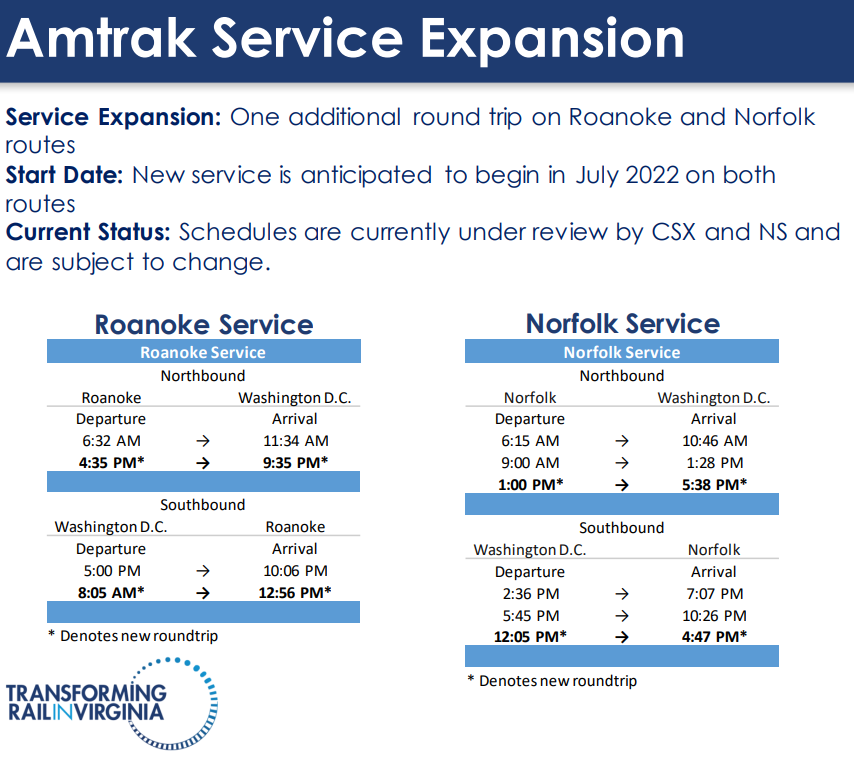
a second Amtrak train to Roanoke was announced in 2022
Source: Virginia Passenger Rail Authority, Western Rail Initiative Brief and Related Amtrak Service Improvements (VPRA Board Meeting – May 2022, slide 17)
The expansion followed Amtrak's strategy of adding short-haul trips where travelers were frustrated by traffic congestion. The passenger rail network planned to grow by extending existing routes to nearby urban areas, rather than pushing for brand-new routes.
Extending service from Christiansburg to Bristol was projected to cost over $500 million in capital improvements, with one estimate as high as $1.5 billion. That estimate included constructing new track and a tunnel through Vicker Heights. With the tunnel, service to the Christiansburg station from Bristol could avoid backtracking to connect to the existing CSX line.
The low-cost proposal assumed new stations would be built at Radford, Pulaski, Wytheville, Marion, and Abingdon. Cost could be reduced about $100 million by eliminating those stations. Each stop also required two minutes. Eliminating some or all of the proposed stations would speed service and reduce costs, but also require potential passengers living near those communities to get to either Bristol or Roanoke in order to catch the train.
By 2040, the state expected 9,700 and 15,500 new one-way riders on the Bristol extension. Future operating costs for a Bristol extension, with one northbound and one southbound train each weekday plus a single train on Saturdays and Sundays, was estimated at about $5 million annually. Revenue from passengers was estimated at $500,000 to $715,000 annually.
The vision of extending Amtrak to Bristol was maintained when Governor Glenn Youngkin appointed the Chief Executive Officer of the Bristol Chamber of Commerce to the Virginia Passenger Rail Authority board of directors. She had helped organize the To and Thru Bristol Passenger Rail Coalition.
Virginia officials anticipated that passenger rail to Bristol would be cost-effective only if Tennessee planned for an extension to reach Knoxville, at a minimum. Unlike Virginia, Tennessee had no state-supported routes for Amtrak trips less than 750 miles. The one passenger rail travel in Tennessee, the City of New Orleans route, was fully funded by Amtrak as a long-distance route.
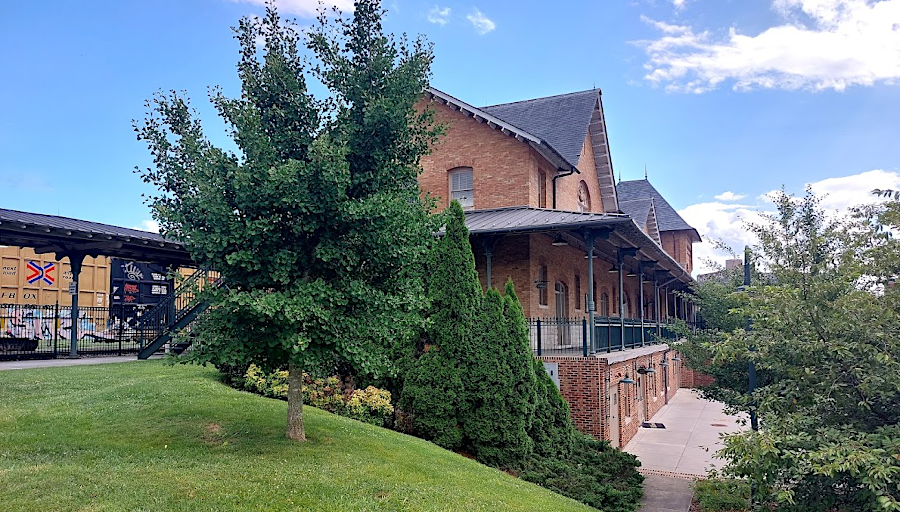
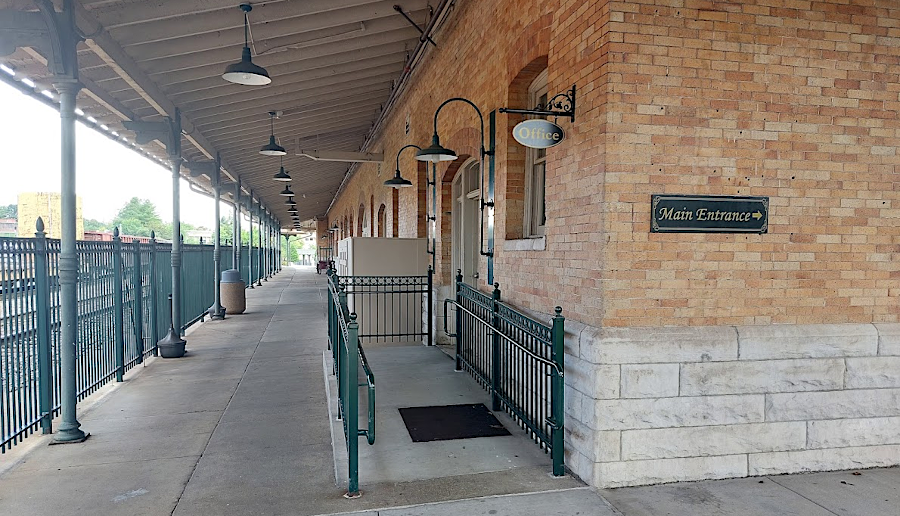
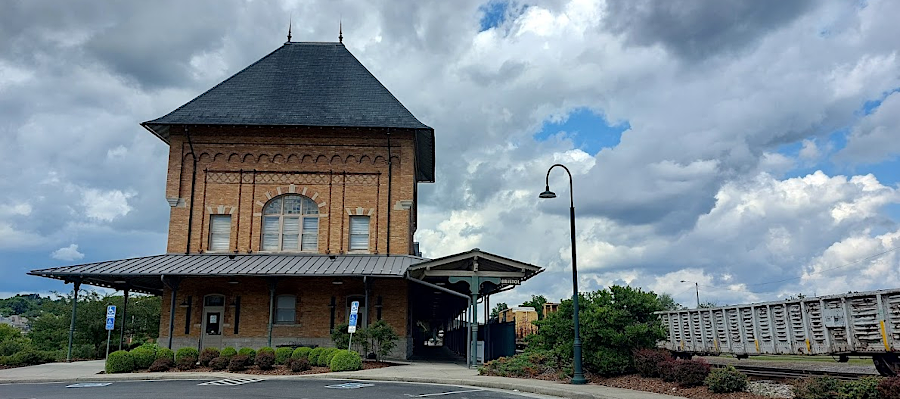
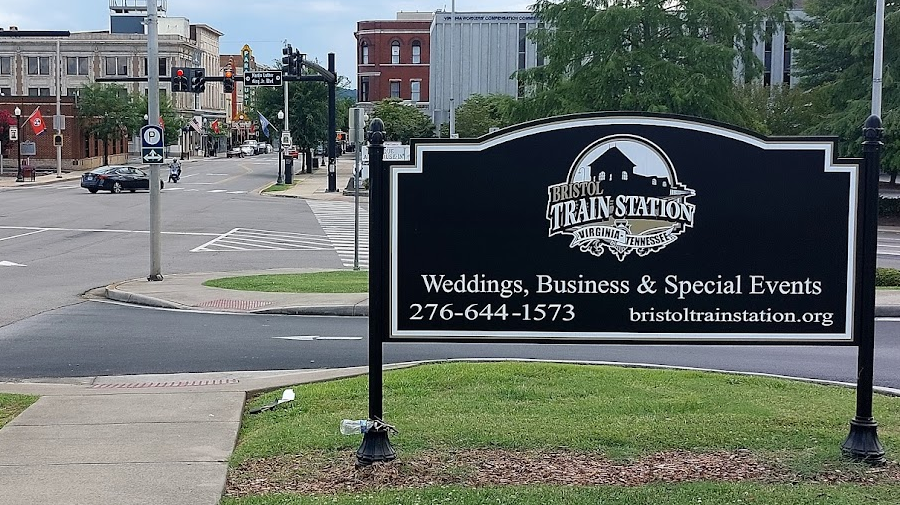
the train station in Bristol was used just as an event center in 2023, but had plenty of space for servicing Amtrak customers
A 2023 study assessed the potential of a Chattanooga-Knoxville-Bristol route as well as four other choices. Two possibilities, Nashville-Chattanooga-Atlanta and Memphis-Nashville, had higher potential ridership as shorter routes connecting larger cities. Two other routes, Memphis-Chicago and Nashville-Louisville, would have higher costs than Bristol-Knoxville-Chattanooga.
Only 30 miles of Norfolk Southern's 235 miles of Bristol-Chattanooga track was double-tracked. Freight trains moved at 40-50 miles per hour, and only 10 miles per hour on some portions. Driving between Bristol-Knoxville-Chattanooga would be significantly faster than taking the train.
Cost to upgrade the track, as well as future operating costs, were the primary barrier to extending passenger rail south of Bristol. The editor of Cardinal News argued that transit was a public service rather than a profitable business, and a public subsidy for a passenger train to Bristol was justified:30
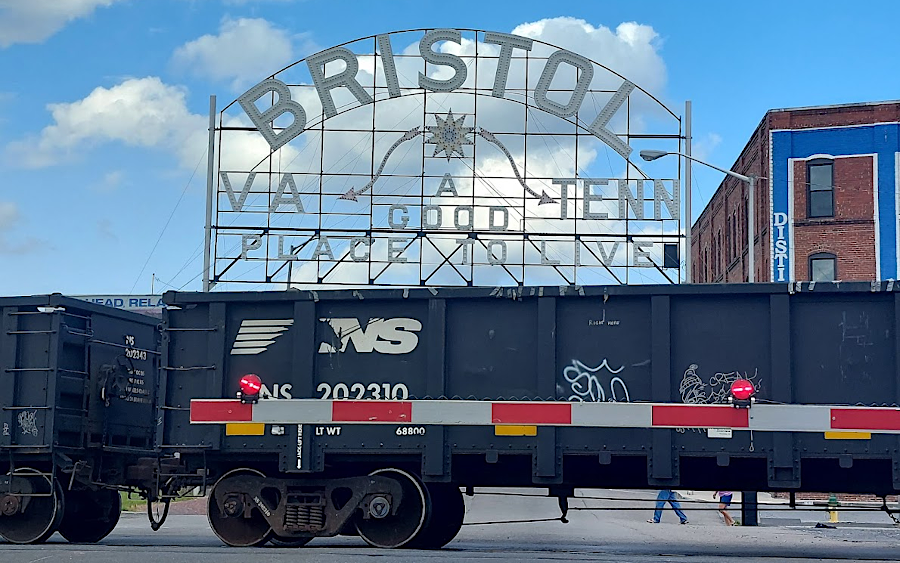
in 2023, only freight trains blocked traffic on State Street in Bristol
Both Republican and Democratic governors have supported increasing passenger rail service in Virginia. Democratic Governor Warner championed the first state investment in rail infrastructure in 2004. In 2011, Republican Governor Bob McDonnell supported dedicating a percentage of the state sales tax to guaranteed continued funding for rail projects.
Governor Northam and the General Assembly chose to invest $3.7 billion in acquiring CSX rail assets in part to solve traffic congestion on I-95 rather than widen the interstate again. The Virginia Secretary of Transportation justified funding the Transform Rail in Virginia initiative to enhance passenger rail service in the Washington-Richmond corridor rather than expanding I-95 again:31
Source: Partnership for Smarter Growth, Climate Investments in Virginia: Advocating for Rail in Virginia
Restoring passenger service between Richmond-Charlottesville was part of the state's vision. Amtrak had started the Mountaineer in 1975, a train connecting Norfolk with Cincinnati. Demand was too low to justify the cost, but influential West Virginia Senator Robert Byrd ensured that service continued to his state. The Mountaineer was replaced with the Hilltopper in 1977. It ran from Washington DC to Catlettsburg, West Virginia, on the Ohio River. From there, passengers could catch a different train to go west to Chicago. The switch to The Hilltopper in 1977 eliminated the Norfolk-Petersburg connection.
The Hilltopper ran south through Richmond to Petersburg, then west via Lynchburg, Roanoke, and Christiansburg to the Ohio River. The number of passengers did not justify the expense, and despite Sen. Byrd's support the train was cancelled in 1978. The Hilltopper was the last east-west passenger train across Virginia in the Twentieth Century.
In 2023, the US Department of Transportation awarded a $500,000 planning grant for the Commonwealth Corridor. The Washington, D.C., to Bristol, VA, Corridor was also awarded a $500,000 planning grant, also funded through the 2021 Infrastructure Investment and Jobs Act. Both corridors had been designated in 2022 in the Corridor Identification and Development Program of the Federal Railroad Administration.
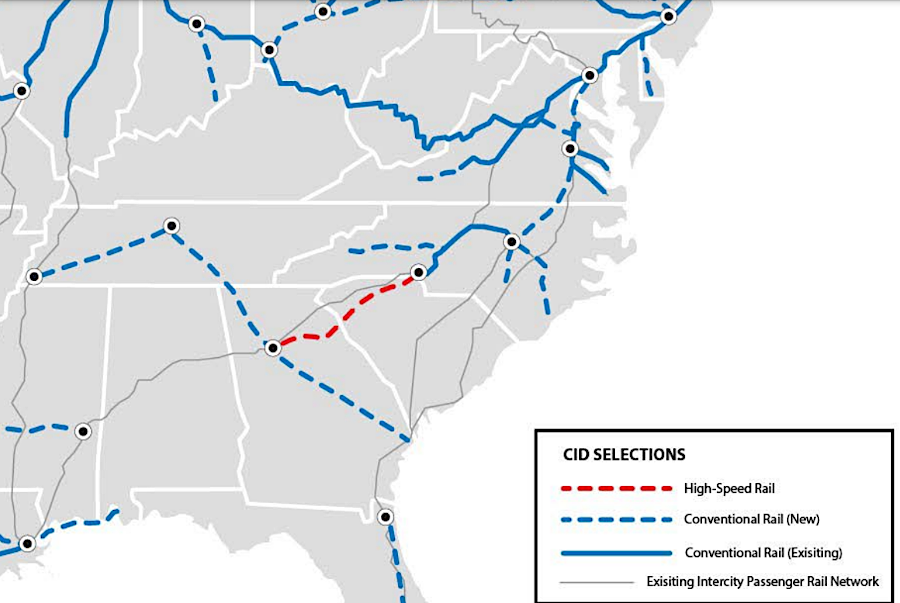
Federal funding is planned to flow to improve track in the Commonwealth Corridor and the Washington, D.C., to Bristol, VA, Corridor
Source: Federal Railroad Administration, FY22 Corridor Identification
and Development Program Selections
East-west passenger rail was intended to connect Hampton Roads to Roanoke and the New River Valley, as well as Richmond to Charlottesville. Construction costs on segments of the Buckingham Branch, CSX, and Norfolk Southern railroads were projected at $416 million, with most of the expense between Gordonsville-Doswell where the railbed had not already been upgraded to provide passenger service.
Until service actually begins, a rail trip from Richmond to Charlottesville will continue to require 8.5 hours compared to a one-hour drive on I-64. Currently a Norfolk-Roanoke rail trip requires 16 hours, compared to a four-hour drive. Two round-trip trains per day between Newport News-Blacksburg were projected to carry 170,000 passengers per year. With Federal funding, service on the Commonwealth Corridor might start in the 2030's. If the project relied upon mostly state funding, passenger trains might begin running directly between Richmond-Charlottesville in the 2040's.32
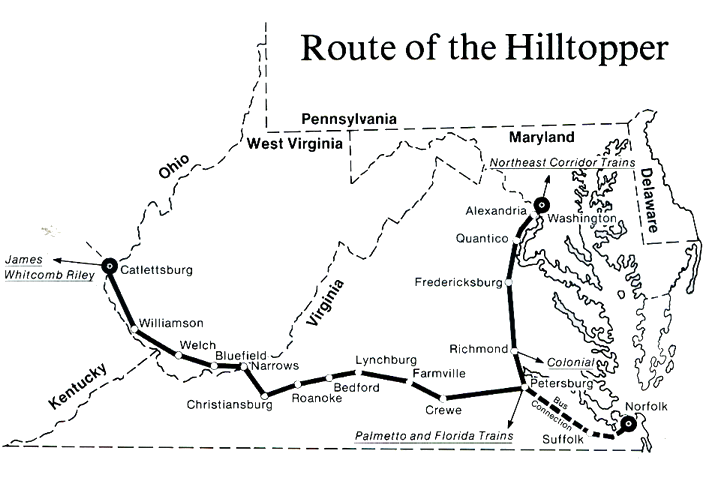
the Hilltopper, cancelled in 1978, was the last east-west passenger train to cross Virginia in the 20th Century
Source: Wikipedia, Hilltopper (train)
In 2019, a coalition composed of the Virginians for High Speed Rail, the Southern Environmental Law Center, the Hampton Roads Chamber, Virginia21, and Roanoke Regional Chamber started another push for the General Assembly to support the "Commonwealth Corridor" to enhance east-west rail service.
The route was also known as the "college corridor," because it would link Old Dominion University and Norfolk State University in southern Hampton Roads to Virginia Tech and Radford in Southwest Virginia. Students at 35 higher education institutions, 65% percent of the college students in Virginia, could access trains on the proposed route.
The Commonwealth Corridor would require expensive upgrades to existing rail lines, acquisition of new equipment, and negotiations with the Norfolk Southern, CSX, and Buckingham Branch railroads to use their privately-owned track. Advocates acknowledged:33
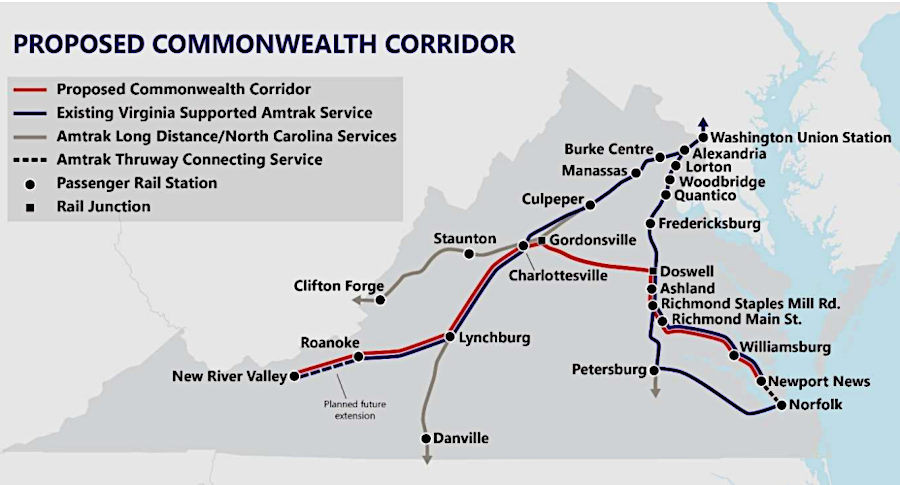
the Commonwealth Corridor proposed in 2021 would pass through Charlottesville, unlike the Hilltopper than went through Lynchburg
Source: Virginia Department of Rail and Public Transportation, 2021 Commonwealth Corridor Feasibility Study (Figure 1-1)
The 2020 General Assembly required the Virginia Department of Rail and Public Transportation to evaluate the potential of east-west passenger train service. The 2021 Commonwealth Corridor Feasibility Study proposed service from Newport News to Christiansburg. Choosing Newport News rather than Norfolk as the eastern terminus would save an hour of travel.
The estimated cost in 2022, including rebuilding 50 miles of track, was $400 million. If completed, trains using the Commonwealth Corridor could go between Newport News-Blacksburg in seven hours. Driving via I-64 and I-81 would require about 4.5 hours.
The proposed route would serve universities and colleges in Hampton, Newport News, Williamsburg, Petersburg, Richmond, Ashland, Charlottesville, Lynchburg, and Roanoke. If the Commonwealth Corridor had been routed like the Hilltopper instead, then students at Longwood University and the College of Hampden Sydney would have been able to board the train in Farmville.
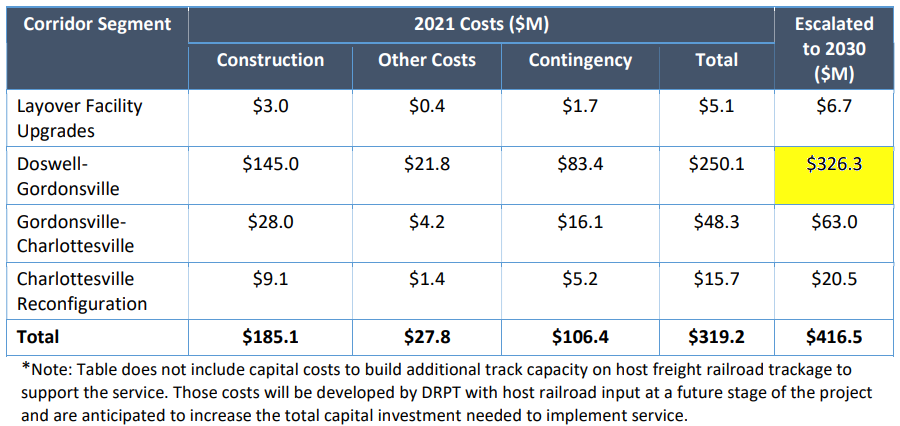
most of the projected costs for the Commonwealth Corridor were for track improvements between Doswell-Gordonsville
Source: Virginia Department of Rail and Public Transportation, 2021 Commonwealth Corridor Feasibility Study (Table 1.2)
The state study proposed two trains daily in each direction. Most of the 177,200 passengers projected to use the Commonwealth Corridor by 2040 would be coming to or leaving from Charlottesville.
Over 75% of the projected $416 million in capital costs was planned for upgrading the 49 miles of former CSX track between Gordonsville and Doswell. The Roanoke-Christiansburg section was already scheduled for a track upgrade, and the rest of the route was already being used by Amtrak.34
Maine was another state that succeeded in expanding Amtrak service, largely due to public support and a state commitment to facilitate expansion. In the words of one advocate, the business case justifying expansion was solid:35
The Newport News Transportation Center opened on August 22, 2024. The first designs were produced back in 2012. Completing the $53 million facility required cooperation among Amtrak, Virginia Passenger Rail Authority (VPRA), CSX, the Federal Railroad Administration (FRA), the Virginia Department of Rail and Public Transportation (DRPT) and the Virginia Department of Transportation (VDOT) as well as the City of Newport News.
The new center was nine miles away from the old Amtrak station. It provided better connections between the two daily Amtrak Virginia roundtrips and regional bus services. In addition to improved services for passengers, a maintenance facility provided space for trains to be cleaned and washed before heading north again to Union Station in Washington, DC.
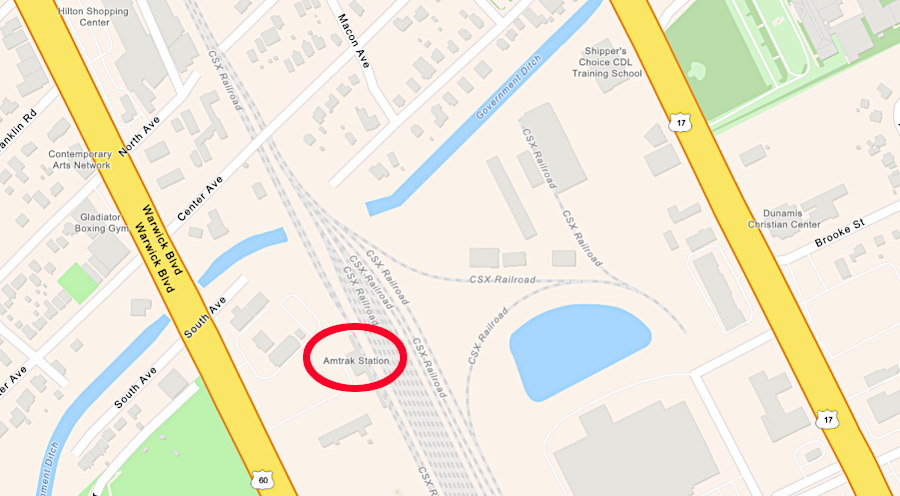
the former Amtrak station was at 9304 Warwick Boulevard in Newport News
Source: ESRI, ArcGIS Online
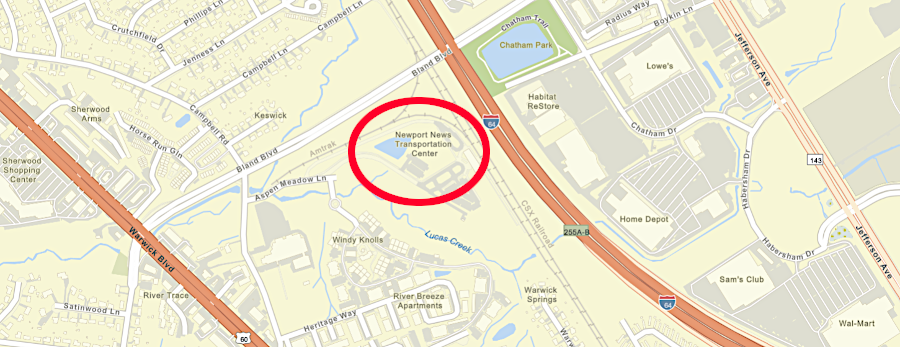
the new multimodal Newport News Transportation Center, nine miles from the former Amtrak station, provided better connections to the regional bus system
Source: ESRI, ArcGIS Online
In South Hampton Roads, the public had a harder time using the Amtrak station once construction of the casino at Harbor Park finally started in 2025. Parking Lot D next to the train station was closed. Customers were obliged to park so far away that the casino had to provide shuttle service for an hour before and after trains arrived.
In October 2025 Hampton Roads Transit revised the schedule of "The Tide" trains at Harbor Park Station to expand transit service from downtown Norfolk and align better with the arrival and departure of Amtrak trains. Additional Tide trips were added in the evening to match the 8:30pm arrival of Amtrak, and in the morning for the 6:14am train departing to Washington DC.37
Plans to add third daily roundtrip Amtrak train between Newport News-Washington, DC and Norfolk-Washington, DC in 2026 were postponed until at least 2030. Construction of a new Long Bridge, adding two new railroad tracks over the Potomac River, created scheduling conflicts for use of the existing two tracks by Virginia Railway Express and CSX freight train.
The bridge construction also required eliminating the early morning departure and early afternoon arrival of Amtrak trains in Newport News. The Virginia Passenger Rail Authority substituted an express bus, leaving from the Virginia Beach Oceanfront and stopping at the Norfolk and Newport News Amtrak stations.36
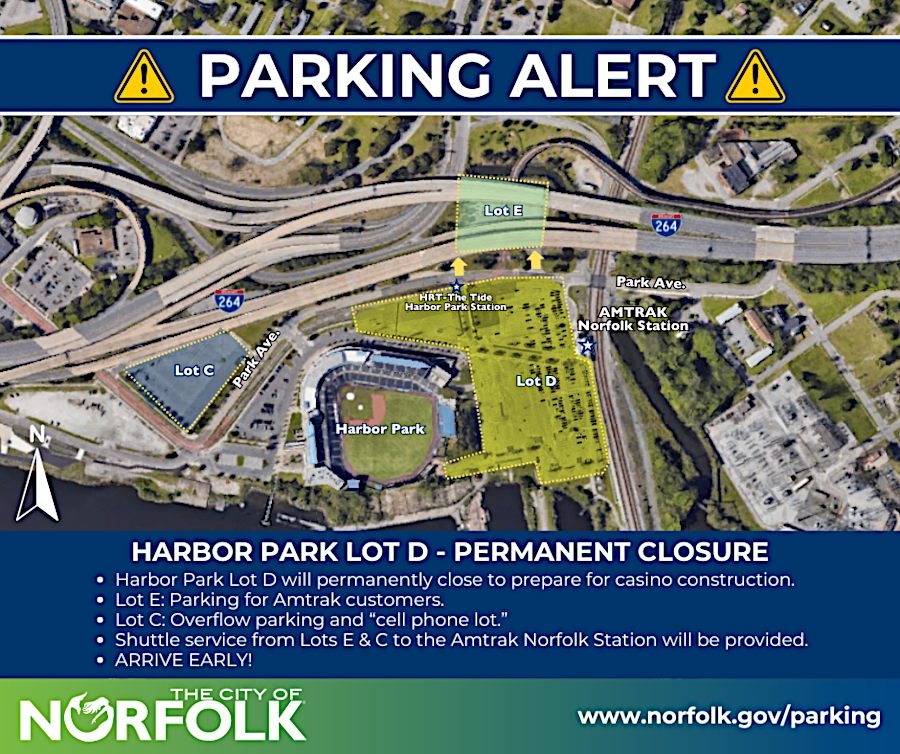
Norfolk Amtrak station customers had to rely upon shuttle buses from more-distant parking lots, once construction of the casino started in January, 2025
Source: City of Norfolk, Harbor Park Parking Alert (January 25, 2025)
Suffolk officials were frustrated than Amtrak passenger trains went through town next to the historic passenger depot without stopping. A preliminary study identified 10 possible locations for a Suffolk stop. The old depot offered the minimum size of two acres, but was not acceptable because it lacked a long enough stretch of straight track between crossings.
Of the three most suitable locations, two were in industrial areas. One was on a dead end track, requiring trains to spend extra time backing out. The other was next to the Golden Peanut parcel already planned for redevelopment but would require purchasing occupied houses. The third site was near downtown, which was preferred. That site would require closing Commerce Street so it would no longer cross the trailroad tracks.
The city's next step was to complete a feasibility study to show that adding an Amtrak stop in Suffolk would not reduce existing traffic from Norfolk or Newport News. City officials sought an Amtrak station to improve the local quality of life more than to attract new business. The City Manager of Suffolkk noted that driving east to the Amtrak station in Norfolk to catch a train that then ran west right through downtown Suffolk involved excessive delay:38
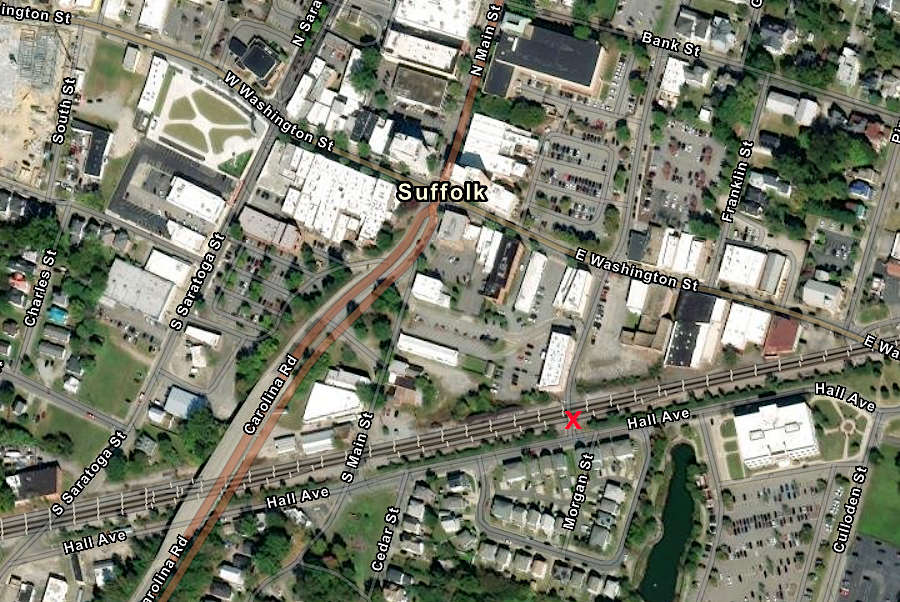
the downtown site for an Amtrak station in Suffolk would require closing Commerce Street where it crossed the tracks (red X)
Source: ESRI, ArcGIS Online
There are three types of Amtrak services passing through Virginia. The long-distance intercity service funded by Amtrak included six named trains: the Cardinal, Crescent, Palmetto, Silver Meteor, Silver Star, and Auto Train. Virginia funded regional intercity service on four routes that connected Washington DC to Richmond, Newport News, Norfolk, and Roanoke, as extensions of Amtrak's Northeast Regional service. The Virginia Passenger Rail Authority (VPRA) is responsible for operations and mainenance costs of the trains, plus the capital costs for new equipment.
North Carolina funded the Carolinian, an interstate corridor service that connected Washington DC to Charlotte. On the busiest days, there were 30 trains using the 11 routes.39
According to the Virginia Passenger Rail Authority:40

each of the four state-supported Amtrak routes set a new record for passengers in 2024
Source: Virginia Passenger Rail Authority, Amtrak Virginia Sets All-Time Record with 2024 Ridership

stations in Virginia where the Silver Meteor, Silver Star, Palmetto, and Carolinian passenger trains stop
Source: Amtrak, Carolinian/Piedmont Timetables

Federal investment in intercity transportation, 1949-2008 (2009 constant dollars)
Source: Federal Railroad Administration, Vision for High Speed Rail in America (Figure 4)
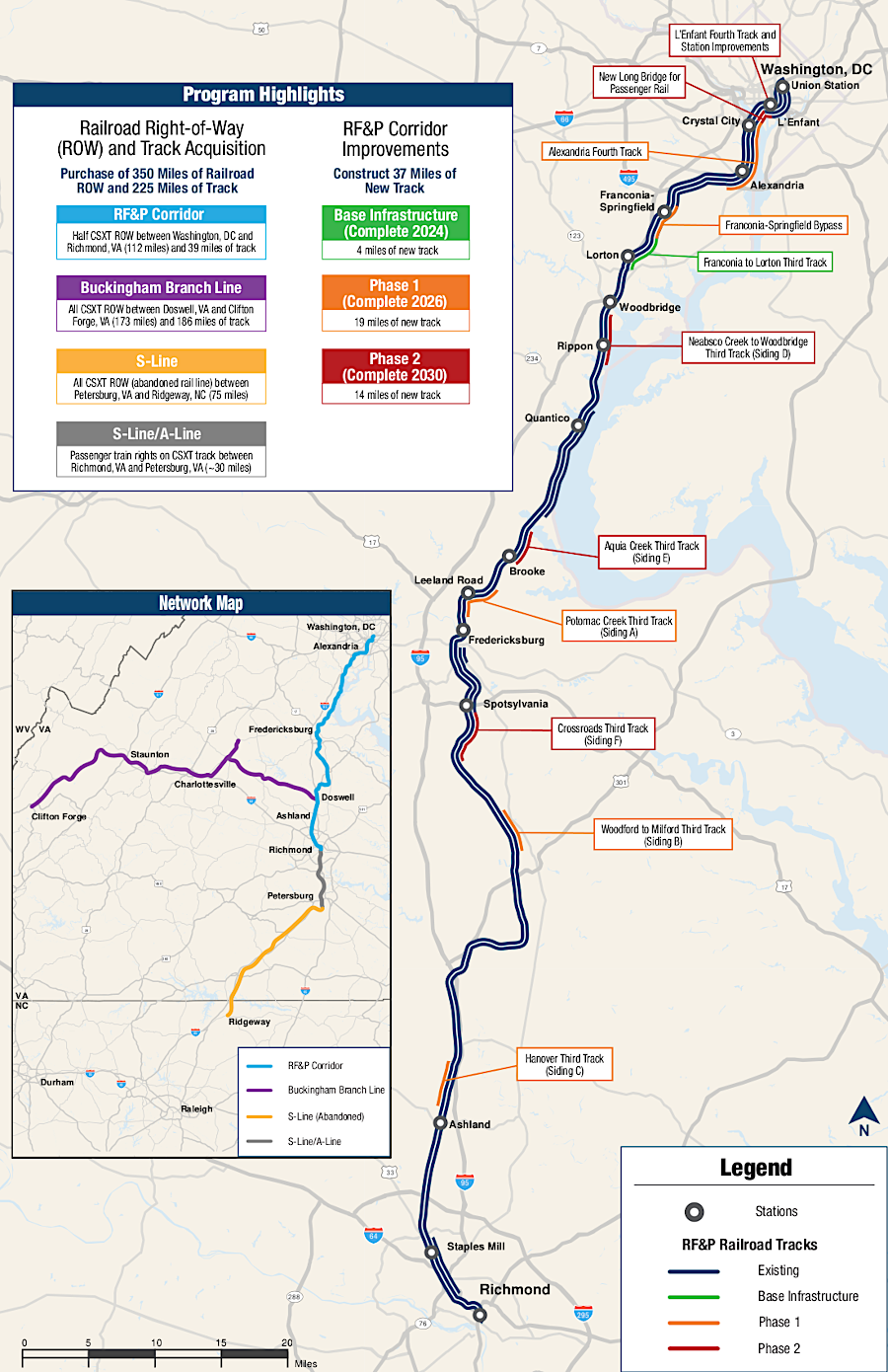
in 2019, Governor Northam announced a $3.7 billion plan to acquire track and expand passenger rail
Source: Virginia Department of Rail and Public Transportation, Map of Future Program Highlights
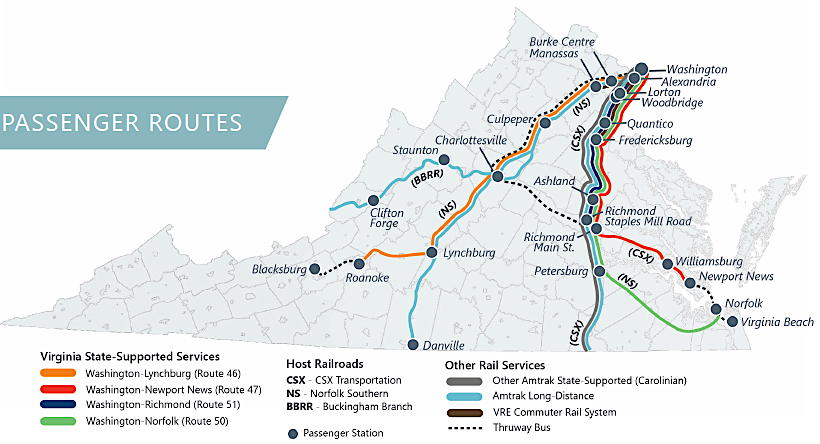
in 2020, the next planned extension of passenger rail in Virginia was to Christiansburg/Blacksburg
Source: Virginia Department of Rail and Public Transportation, Virginia's Rail Network (2020)
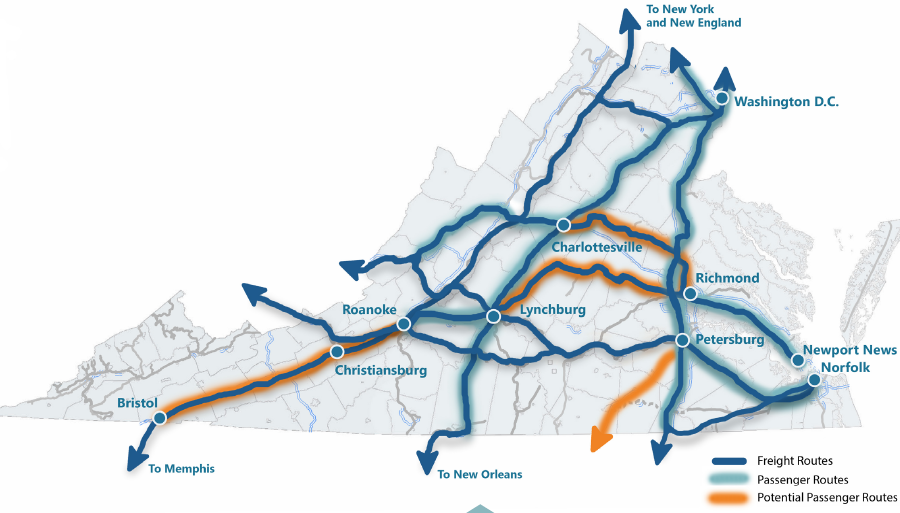
after Christiansburg/Blacksburg, passenger rail extensions were planned to Bristol, Raleigh (NC), and creation of east-west routes from Richmond
Source: Virginia Department of Rail and Public Transportation, Virginia's Rail Network (2020)
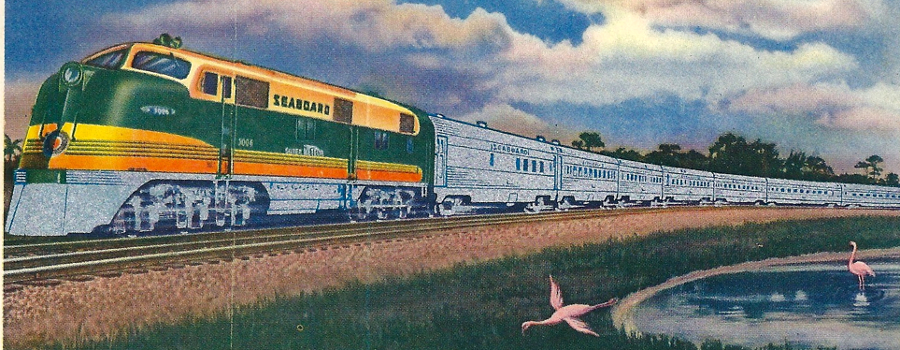
starting in 1939, Seaboard Air Line offered daily trips on the Silver Meteor through Virginia, connecting Richmond to New York and Miami/Tampa-St. Petersburg
Source: Streamliner Memories, The Silver Meteor
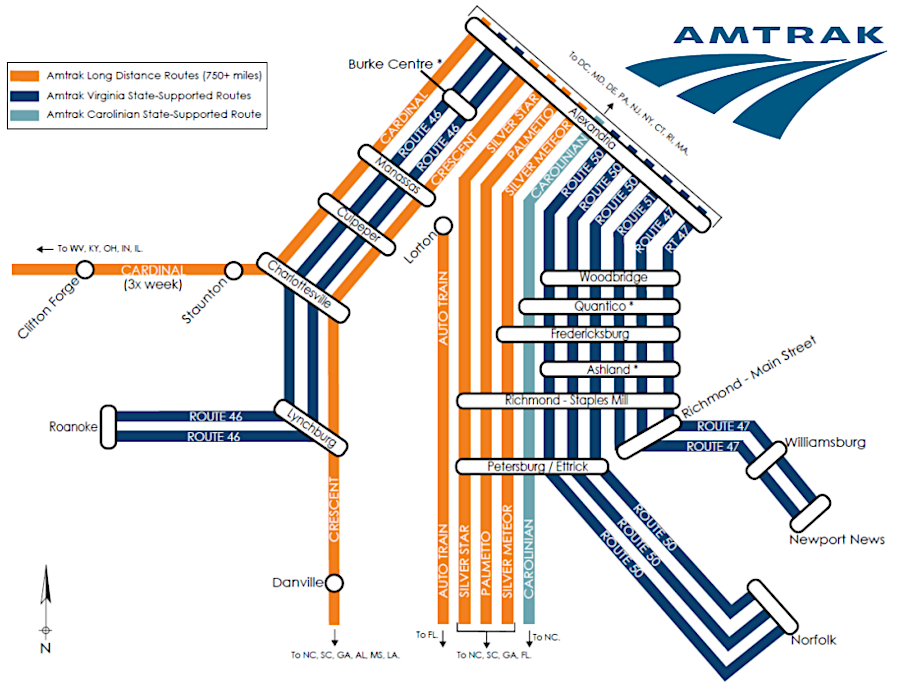
Amtrak service in Virginia in 2023 included two trains daily to Roanoke and three to Norfolk
Source: Virginia Passenger Rail Authority, VPRA's Relationships with Passenger Rail Operators (December 6, 2023)